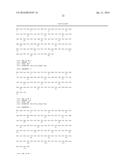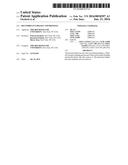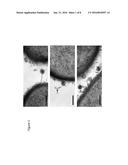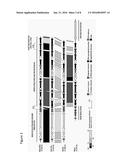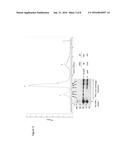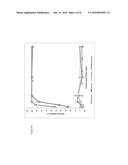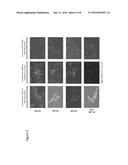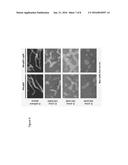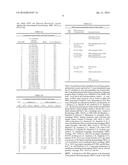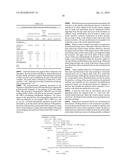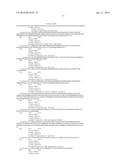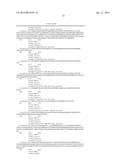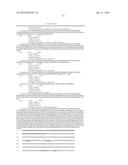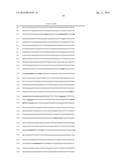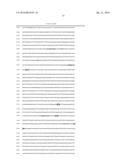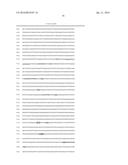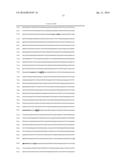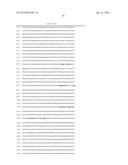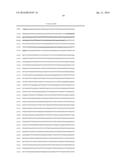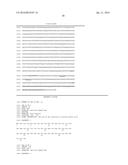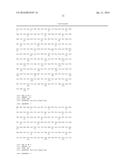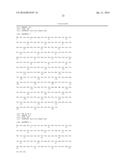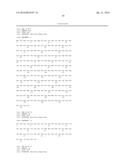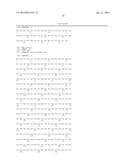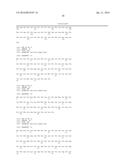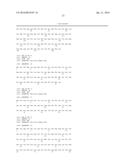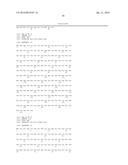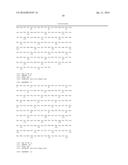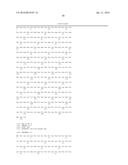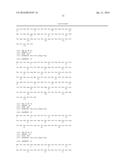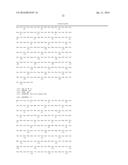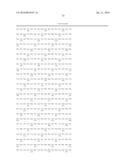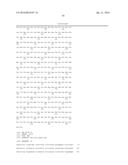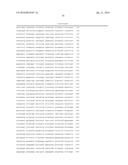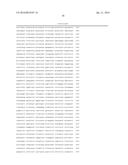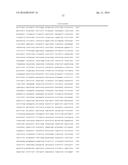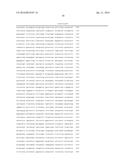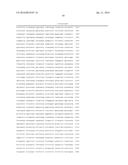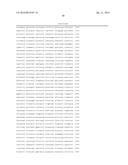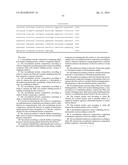Patent application title: RECOMBINANT PHAGES AND PROTEINS
Inventors:
Assignees:
THE ROCKEFELLER UNIVERSITY
IPC8 Class: AG01N33569FI
USPC Class:
506 9
Class name: Combinatorial chemistry technology: method, library, apparatus method of screening a library by measuring the ability to specifically bind a target molecule (e.g., antibody-antigen binding, receptor-ligand binding, etc.)
Publication date: 2016-01-21
Patent application number: 20160018397
Abstract:
The present disclosure provides recombinant phages, a Wip1 p23 receptor
binding protein and a Wip1 p24 receptor binding protein that bind to
Bacillus anthracis. The disclosure further provides methods and uses
thereof.Claims:
1. A recombinant protein composition comprising Wip1 p23 receptor binding
protein, variants or fragments thereof.
2. The recombinant protein composition according to claim 1, wherein the recombinant protein composition further comprises Wip1 p24 receptor binding protein, variants or fragments thereof.
3. The recombinant protein composition according to claim 1, wherein the Wip1 p23 receptor binding protein further comprises a reporter molecule.
4. The recombinant protein composition according to claim 4, wherein the reporter molecule is a fluorophore, a fluorophore/quencher pair, an antibody, a llama-body, an isotope, or combinations thereof.
5. The recombinant protein composition according to claim 1, wherein the Wip1 p23 receptor binding protein is capable of binding Bacillus anthracis.
6. The recombinant protein composition according to claim 1, further comprising a substrate.
7. The recombinant protein composition according to claim 1, wherein the substrate is an array.
8. A system for detecting Bacillus anthracis comprising a recombinant protein composition according to claim 1, and a detector in communication with said recombinant protein composition, wherein the detector is capable of detecting a signal generated upon recognition of a Bacillus anthracis receptor by the recombinant protein composition.
9. The system according to claim 8, further comprising a light source in optical communication with the recombinant protein composition.
10. The system according to claim 8, further comprising a processor for processing signals detected by the detector.
11. A method of identifying or detecting Bacillus anthracis in a sample, the method comprising: (a) providing a sample suspected of containing Bacillus anthracis; (b) contacting the sample with a recombinant protein composition according to claim 1, wherein a change in a signal generated by a reporter molecule indicates the presence of Bacillus anthracis in the sample.
12. The method according to claim 11, wherein the sample is a biological sample or environmental sample.
13. The method according to claim 11, wherein the reporter molecule is a fluorophore or flurophore/quencher pair.
14. The method according to claim 11, wherein the recombinant protein composition changes conformation when contacting a Bacillus anthracis receptor thereby changing detectable properties of the recombinant protein composition.
15. An isolated nucleic acid encoding a Wip1 p23 receptor binding protein, a Wip1 p24 receptor binding protein, a variant thereof, or combination thereof, wherein the Wip1 p23 receptor binding protein, Wip1 p24 receptor binding protein, variants or combinations thereof bind to Bacillus anthracis.
16. The isolated nucleic acid according to claim 15, wherein the isolated nucleic acid is operably linked to a regulatory element, reporter, a detectable element, or combinations thereof.
17. The isolated nucleic acid according to claim 15, wherein the isolated nucleic acid is a cDNA.
18. A recombinant expression vector comprising the isolated nucleic acid according to claim 15.
19. A recombinant expression composition comprising recombinant expression vector according to claim 18.
20. The recombinant expression composition according to claim 19, wherein the recombinant expression composition further comprises a detectable element.
Description:
CROSS REFERENCE TO RELATED APPLICATIONS
[0001] This application claims priority to U.S. Provisional Application No. 61/846,287, filed on Jul. 15, 2013, the disclosure of which is incorporated herein by reference.
FIELD OF THE INVENTION
[0003] The invention relates to bacteriophages that inhibit the growth of Gram positive and Gram negative bacterial cells. These bacteriophages are useful to identify and treat pathogenic bacteria.
BACKGROUND OF THE INVENTION
[0004] Bacteriophage-based diagnostics and therapeutics have been recognized as tools to combat bacterial infections for nearly a century. Wip1 (for worm intestinal phage 1) is a recently identified phage that infects the pathogen Bacillus anthracis and was isolated from the intestinal tract of Eisenia fetida worms [Schuch, R., et al., Prevalence of Bacillus anthracis-like organisms and bacteriophages in the intestinal tract of the earthworm Eisenia fetida. Applied and environmental microbiology, 2010. 76(7): p. 2286-94]. It is a tailless, double-stranded DNA phage possessing an internal lipid membrane beneath an icosahedral protein coat [Schuch, R. F. V. A., The Secret Life of the Anthrax Agent Bacillus Anthracis: Bacteriophage-Mediated Ecological Adaptations. PLos One, 2009. 4(8): p. e6532]. These features indicate that Wip1 belongs to the family Tectiviridae, a relatively rare phage group with surprising structural similarity to and a proposed evolutionary lineage with the mammalian adenovirus [Merckel, M. C. H., J. T.; Bamford, D. H.; Goldman, A.; Tuma, R., The Structure of the Bacteriophage PRD1 Spike Sheds Light on the Evolution of Viral Capsid Architecture. Molecular Cell, 2005. 18: p. 161-170, Bamford, D., Evolution of Viral Structure. Theoretical Population Biology, 2002. 61(4): p. 461-470.]. The Tectiviridae family consists of six isolates that infect gram-negative bacteria, including PRD1 [Olsen, R. H. S., J.; Gray, R. H., Characteristics of PRD1, a Plasmid-Dependent Broad Host Range DNA Bacteriophage. Journal of Virology, 1974. 14(3): p. 689-699], and six that infect gram-positive bacteria, including Bam35, Gi116, AP50, and Wip1 [Schuch, R., et al., Prevalence of Bacillus anthracis-like organisms and bacteriophages in the intestinal tract of the earthworm Eisenia fetida. Applied and environmental microbiology, 2010. 76(7): p. 2286-94; Ackermann, H. W. R., R.; Martin, M.; Murthy, M. R.; Smirnoff, W. A., Partial Characterization of a Cubic Bacillus Phage. Canadian Journal of Microbiology, 1978. 24: p. 986-993; Verheust, C., N. Fornelos, and J. Mahillon, GIL16, a new gram positive tectiviral phage related to the Bacillus thuringiensis GIL01 and the Bacillus cereus pBClin15 elements. Journal of bacteriology, 2005. 187(6): p. 1966-73; Nagy, E. P., B.; Ivanovics, G., Characteristics of Phage AP50, an RNA Phage Containing Phospholipids. Journal of General Virology, 1976. 32: p. 129-132]. While PRD1 has been studied in detail, tectiviruses that infect gram-positive bacteria are not as well characterized.
[0005] Wip1 phage exhibits a very narrow host range and is highly specific to B. anthracis [Schuch, R., et al., Prevalence of Bacillus anthracis-like organisms and bacteriophages in the intestinal tract of the earthworm Eisenia fetida. Applied and environmental microbiology, 2010. 76(7): p. 2286-94], the notorious biothreat agent and gram-positive bacterium that causes anthrax disease. The current gold standard for identifying suspected B. anthracis involves testing for γ phage sensitivity [Abshire, T. G., J. E. Brown, and J. W. Ezzell, Production and validation of the use of gamma phage for identification of Bacillus anthracis. Journal of clinical microbiology, 2005. 43(9): p. 4780-8; Anthrax Q & A: diagnosis. 2002; Available from: www.bt.cdc.gov/agent/anthrax/faq/diagnosis.asp]. However, using γ as a diagnostic tool can lead to false positives due to the susceptibility of several Bacillus cereus strains to infection by this phage [Schuch, R. and V. A. Fischetti, Detailed genomic analysis of the Wbeta and gamma phages infecting Bacillus anthracis: implications for evolution of environmental fitness and antibiotic resistance. Journal of bacteriology, 2006. 188(8): p. 3037-51; Schuch, R. N., D.; Fischetti, V. A., A bacteriolytic agent that detects and kills Bacillus anthracis. Nature, 2002. 418: p. 884-889]. Recent studies have shown that the host range of γ is less specific to B. anthracis than those of tectiviruses Wip1 and AP50 [Schuch, R., et al., Prevalence of Bacillus anthracis-like organisms and bacteriophages in the intestinal tract of the earthworm Eisenia fetida. Applied and environmental microbiology, 2010. 76(7): p. 2286-94; Sozhamannan, S., et al., Molecular Characterization of a Variant of Bacillus anthracis-Specific Phage AP50 with Improved Bacteriolytic Activity. Applied and environmental microbiology, 2008. 74(21): p. 6792-6796]. For example, Bacillus cereus ATCC 4342 is sensitive to infection by γ phage but not to infection by either Wip1 or AP50. Additionally, the γ diagnostic phage yields plaques on B. anthracis ΔSterne only after 5 days, whereas Wip1 plaques can be detected after just 12 hours post infection [Schuch, R., et al., Prevalence of Bacillus anthracis-like organisms and bacteriophages in the intestinal tract of the earthworm Eisenia fetida. Applied and environmental microbiology, 2010. 76(7): p. 2286-94].
[0006] Wip1's high specificity to B. anthracis is likely mediated by the initial recognition and binding of the virus to the host cell. Receptor binding proteins on the phage coat interact very specifically with receptors exposed on the surface of the bacterium [Haywood, A. M., Virus receptors: binding, adhesion strengthening, and changes in viral structure. Journal of virology, 1994. 68(1): p. 1-5]. For tectiviruses, the receptor binding protein assembles with other phage proteins into a protruding complex that extends from each particle vertex [Sokolova, A., et al., Solution structure of bacteriophage PRD1 vertex complex. The Journal of biological chemistry, 2001. 276(49): p. 46187-95]. In the PRD1 spike complex, two elongated proteins, monomeric receptor binding protein P2 and trimeric spike protein P5, form two separate spikes that each protrude from penton base protein P31 [Bamford, J. K. B., D. H., A New Mutant Class, Made by Targeted Mutagenesis, of Phage PRD1 Reveals That Protein P5 Connects the Receptor Binding Protein to the Vertex. Journal of virology, 2000. 74(17): p. 7781-7786; Huiskonen, J. T., V. Manole, and S. J. Butcher, Tale of two spikes in bacteriophage PRD1. Proceedings of the National Academy of Sciences of the United States of America, 2007. 104(16): p. 6666-71; Mindich, L. B., D.; McGraw, T.; Mackenzie, G, Assembly of bacteriophage PRD1: particle formation with wild-type and mutant viruses. Journal of virology, 1982. 44(3): p. 1021-1030; Xu, L. B., S. D.; Butcher, S. J.; Bamford, D. H.; Burnett, R. M., The Receptor Binding Protein P2 of PRD1, a Virus Targeting Antibiotic-Resistant Bacteria, Has a Novel Fold Suggesting Multiple Functions. Structure, 2003. 11: p. 309-322].
[0007] Spike complex protein components have also been identified for Bam35, a tectivirus that infects gram-positive Bacillus thuringiensis [Gaidelyte, A., et al., The Entry Mechanism of Membrane-Containing Phage Bam35 Infecting Bacillus thuringiensis. Journal of bacteriology, 2006. 188(16): p. 5925-5934]. By threading Bam35 gene products onto PRD1 X-ray structures, it was determined that gp28 is homologous to spike protein P5 and that gp29 is homologous to the C-terminal half of receptor binding protein P2 [Laurinmaki, P. A. H., J. T.; Bamford, D. H.; Butcher, S. J., Membrane Proteins Modulate the Bilayer Curvature in the Bacterial Virus Bam35. Structure, 2005. 13: p. 1819-1828; Ravantti, J. J. G., A.; Bamford, D. H.; Bamford, J. K., Comparative analysis of bacterial viruses Bam35, infecting a gram positive host, and PRDJ, infecting gram-negative hosts, demonstrates a viral lineage. Virology, 2003. 313: p. 401-414. In addition, gp28 and gp29 were determined to reside on the surface of Bam35 from phage aggregation and neutralization assays using polyclonal antibodies [Gaidelyte, A., et al., The Entry Mechanism of Membrane-Containing Phage Bam35 Infecting Bacillus thuringiensis. Journal of bacteriology, 2006. 188(16): p. 5925-5934]. However, competitive binding assays using both recombinant and dissociated surface proteins were inconclusive, and a Bam35 receptor binding protein could not be identified.
[0008] The described invention addresses these problems, and provides recombinant phage proteins, and uses thereof, to identify and treat pathogenic bacteria.
SUMMARY OF THE INVENTION
[0009] The described invention provides a recombinant protein composition comprising Wip1 p23 receptor binding protein, variants or fragments thereof. The invention further provides a Wip1 p24 receptor binding protein, variants or fragments thereof. The invention further provides a Wip1 p23 receptor binding protein that further comprises a reporter molecule. The invention further provides a reporter molecule that is a fluorophore, a fluorophore/quencher pair, an antibody, a llama-body, an isotope, or combinations thereof. The invention further provides a Wip1 p23 receptor binding protein that is capable of binding Bacillus anthracis. The invention further provides a recombinant protein composition further comprising a substrate. The described invention further provides a native or recombinant Wip1 bacteriophage having affinity for and lytic activity against Bacillus anthracis. The invention further provides a bacteriophage that further comprises a recombinant detectable element, a regulatory element, reporter, or combinations thereof. Furthermore, the described invention provides a recombinant protein composition that comprises the native or recombinant Wip1 bacteriophage having affinity for and lytic activity against Bacillus anthracis.
[0010] The described invention further provides a system for detecting Bacillus anthracis comprising a recombinant protein composition where the recombinant protein combination contains at least one of a Wip1 p23 receptor binding protein, variants or fragments thereof, a Wip1 p24 receptor binding protein, variants or fragments thereof, a native or recombinant Wip1 bacteriophage having affinity for and activity against Bacillus anthracis, or combinations thereof, and a detector in communication with said recombinant protein composition, wherein the detector is capable of detecting a signal generated upon recognition of a Bacillus anthracis receptor by recombinant protein composition. The invention further provides the system further comprising a light source in optical communication with the recombinant protein composition. The invention further provides the system further comprising a processor for processing signals detected by the detector.
[0011] The described invention further provides a method of identifying or detecting Bacillus anthracis in a sample, the method comprising: (a) providing a sample suspected of containing Bacillus anthracis; (b) contacting the sample with a recombinant protein composition where the recombinant protein combination contains at least one of a Wip1 p23 receptor binding protein, variants or fragments thereof, a Wip1 p24 receptor binding protein, variants or fragments thereof, a Wip1 native or recombinant bacteriophage having affinity for and activity against Bacillus anthracis, or combinations thereof, wherein a change in a signal generated by a reporter molecule indicates the presence of Bacillus anthracis in the sample. The invention further provides the method wherein the sample is a biological sample or environmental sample. The invention further provides the method wherein the reporter molecule is a fluorophore or flurophore/quencher pair. The invention further provides the method wherein the recombinant protein composition changes conformation when contacting a Bacillus anthracis receptor thereby changing detectable properties of the recombinant protein composition.
[0012] The described invention further provides an isolated nucleic acid encoding a Wip1 p23 receptor binding protein, a Wip1 p24 receptor binding protein, a variant thereof, or combination thereof, wherein the Wip1 p23 receptor binding protein, Wip1 p24 receptor binding protein, variants or combinations thereof bind to Bacillus anthracis. The invention further provides the the isolated nucleic acid wherein the isolated nucleic acid is operably linked to a regulatory element, reporter, a detectable element, or combinations thereof. The invention further provides the the isolated nucleic acid wherein the isolated nucleic acid is a cDNA.
[0013] The described invention further provides a recombinant expression vector comprising the inventive isolated nucleic acids.
[0014] The described invention further provides a recombinant expression composition comprising the inventive recombinant expression vector. The invention further provides the recombinant expression composition wherein the recombinant expression composition further comprises a detectable element.
BRIEF DESCRIPTION OF THE DRAWINGS
[0015] The patent or application file contains at least one drawing executed in color. Copies of this patent or patent application publication with color drawing(s) will be provided by the Office upon request and payment of the necessary fee.
[0016] FIG. 1 shows TEM of the Wip1 phage on B. anthracis. Wip1 was incubated with B. anthracis ΔSterne for 5 minutes at a MOI of 10 before being fixed for TEM imaging. Scale bar=0.1μ.
[0017] FIG. 2 shows alignment of Bam35c, Gil16c, AP50 and Wip1 genome maps. Predicted genes are represented as block arrows and the color key in the bottom right indicates postulated functions. Shaded regions pair conserved sequence segments between phages and amino acid identity, percentage ranges are shown in the lower left corner.
[0018] FIG. 3 shows purified proteins. The Ni-NTA eluate containing both his-p23 and p24 (Lane 1) was further purified by charge using ion exchange chromatography. The distinct peaks were evaluated with SDS-PAGE, which revealed the presence of his-p23 alone in Peak 1 and the presence of his-p23 and p24 together in Peak 2.
[0019] FIG. 4 shows Wip1 inhibition of infectivity by recombinant Wip1 proteins. A) Wip1 phage was assayed for inactivation by recombinant viral proteins at various concentrations. Protein concentrations are indicated per protein. His-p23 (red) and the his-p23+p24 complex (purple) inactivated Wip1 infectivity by up to 100% in a dose-dependent manner.
[0020] His-p22 (blue) and his-p24 (green) did not affect phage activity. Bars represent standard error for a minimum of 3 experiments. B) Anti-his-p23 antibody neutralization of Wip1 activity. Polyclonal antibodies were generated against his-p23 and tested for neutralization of Wip1 activity using methods described. After preincubation with phage, anti-his-p23 (closed circles) inhibited Wip1 adsorption to B. anthracis ΔSterne by up to 90% in a dose-dependent manner. Pre-bleed serum (open circles) did not affect Wip1 adsorption activity. Bars represent standard error of at least 3 experiments.
[0021] FIG. 5 shows indirect immunofluorescence microscopy using his-tagged Wip1 proteins. 1000× magnification.
[0022] FIG. 6 shows indirect immunofluorescence microscopy using his-p23 and the his-p23+p24 complex. 1000× magnification.
[0023] FIG. 7. Following expression and purification methods as described, the recombinant his-tagged Wip1 proteins were then measured using standard BSA assays. Protein solutions were diluted to concentrations of 250 μg/ml for single protein samples (his-p22; his-p23; his-p24) and 500 μg/ml for co-expressed protein samples (his-p23+p24). SDS-PAGE analysis of these protein samples revealed purification to near homogeneity. The samples shown here are the exact samples used in the following protein overlay-based inhibition assays.
DETAILED DESCRIPTION OF THE INVENTION
[0024] The described invention provides a better understanding of Wip1's highly specific tropism for B. anthracis. We started by imaging the morphological changes of Wip1 phage upon adsorption, expanding its host range analysis with adsorption studies, and sequencing its viral genome. Based on genomic analysis with other gram-positive infecting tectiviruses, candidate gene products for the Wip1 spike complex were predicted and used to identify a Wip1 receptor binding protein that detects and exhibits specificity for B. anthracis.
[0025] In the described invention, we characterized the Wip1 phage and its genome to develop the tools to identify the Wip1 gene product 23 as a receptor binding protein. Wip1 tropism was previously shown to be highly specific to B. anthracis. Here, we determined with adsorption assays that specificity to B. anthracis is mediated by Wip1's receptor binding. Indeed, receptor binding protein p23 was demonstrated to bind very specifically to bacterial strains that correspond with Wip1's narrow host range.
[0026] The identification of Wip1 p23 as a receptor binding protein shows that it is a unique protein with no homology to any other known proteins. Additionally, ORF23 shares no sequence identity with AP50, a tectivirus with a similar host range that is also highly specific to B. anthracis. Genomic analysis showed that the overall Wip1 genome shares significant similarities to the AP50 genome in ORF size, sequence, and organization. In fact, the genes neighboring ORF23 display this conservation. ORF22 (291 residues) shares 64% sequence identity with AP50 ORF27 (304 residues) and ORF24 (118 residues) shares 51% sequence identity with AP50 ORF29 (118 residues).
[0027] AP50 ORF28, which is located in the corresponding genomic position to Wip1 ORF23, is the gene that harbors one of two sequence mutations that differentiates isolate AP50t, which produces turbid plaques, from isolate AP50c, which produces clear plaques. Generally, clear plaques are formed when the host is completely susceptible to the phage while turbid plaques are formed if the host is partially resistant to the phage (for example, if 10% of the cells survive infection). Furthermore, AP50 ORF28 and Wip1 ORF23 are located at a highly variable region of their respective genomes. Although the Eip1 receptor-binding domain ORF23 exhibits sequence diversity, it was unexpected that two closely related tectiviruses with a similar host range have evolved uniquely different receptor binding proteins.
[0028] Additionally, it is shown that the his-p23 plus p24 complex exhibited higher competitive inhibition than his-p23 alone, suggesting that p24 complemented or enhanced his-p23 binding activity. This enhancement could result from simply protecting his-p23 proteins from degradation. However, we were careful to use fresh protein stocks in all assays. It also is possible that p24 could play a secondary but complementary role in Wip1 binding. The adsorption of phage to the gram-positive bacterial surface has been suggested to occur in two stages. The first step involves reversible binding to general recognition molecules in the cell wall and is followed by a subsequent irreversible step involving a more specific factor [Jacobson, E. D. L., O. E., Adsorption of bacteriophages phi 29 and 22a to protoplasts of Bacillus substilis. Journal of virology, 1977. 21(3): p. 1223-1227; Monteville, M. R. A., B.; Geller, B. L., Lactococcal Bacteriophages Require a Host Cell Wall Carbohydrate and a Plasma Membrane Protein for Adsorption and Ejection of DNA. Applied and environmental microbiology, 1994. 60(9): p. 3204-3211]. In fact, the seahorse-like structure for PRD1 receptor binding protein P2 consists of multiple domains with different purported functions. In one P2 model, the fin-shaped domain is proposed to make initial contacts by scanning the host surface in order to bring the head domain closer to its receptor [Xu, L. B., S. D.; Butcher, S. J.; Bamford, D. H.; Burnett, R. M., The Receptor Binding Protein P2 of PRDJ, a Virus Targeting Antibiotic-Resistant Bacteria, Has a Novel Fold Suggesting Multiple Functions. Structure, 2003. 11: p. 309-322]. It is possible that Wip1 p24 is such a spike complex domain with non-specific, reversible surface scanning properties.
[0029] Polyclonal antibodies against his-p23 also were able to inactivate Wip1 binding activity. It should be noted, however, that the neutralizing effect of anti-his-p23 serum on Wip1 activity was much weaker compared to that of anti-gp28 or anti-gp29 serum on Bam35 activity [Gaidelyte, A., et al., The Entry Mechanism of Membrane-Containing Phage Bam35 Infecting Bacillus thuringiensis. Journal of bacteriology, 2006. 188(16): p. 5925-5934]. At a mere 20× dilution, anti-his-p23 antibody inactivation measured below 20%. In contrast, anti-gp28 and anti-29 antibodies did not demonstrate inactivation rates below 20% until they reached dilutions of 5,000× and 100,000×, respectively. One explanation for this difference is the possibility that p23 is a poor antigen that generated a weak immunogenic response. However, an indirect ELISA assay determined that the polyclonal antisera against his-p23 exhibited reasonable immunogenic strength (reading of Abs=1 at 1:2000 dilution).
[0030] The narrow infectivity and adsorption host range of Wip1 indicates that its receptor is unique to the exposed surface of B. anthracis and B. cereus CDC32805 in a manner that is accessible to phage. Indirect immunofluorescence microscopy demonstrated that p23 and the p23+p24 complex detect and label B. anthracis with a specificity that seems to match its narrow host range. This activity makes both the Wip1 phage and its receptor molecules useful diagnostic tools for B. anthracis with better specificity than the reagents currently being used.
[0031] The abbreviations used herein for amino acids are those abbreviations which are conventionally used: A=Ala=Alanine; R=Arg=Arginine; N=Asn=Asparagine; D=Asp=Aspartic acid; C=Cys=Cysteine; Q=Gln=Glutamine; E=Glu=Gutamic acid; G=Gly=Glycine; H=His=Histidine; I=Ile=lsoleucine; L=Leu=Leucine; K=Lys=Lysine; M=Met=Methionine; F=Phe=Phenyalanine; P=Pro=Proline; S=Ser=Serine; T=Thr=Threonine; W=Trp=Tryptophan; Y=Tyr=Tyrosine; V=Val=Valine. The amino acids may be L- or D-amino acids. An amino acid may be replaced by a synthetic amino acid which is altered so as to increase the half-life of the peptide or to increase the potency of the peptide, or to increase the bioavailability of the peptide.
[0032] The following represent groups of amino acids that are conservative substitutions for one another: 1) Alanine (A), Serine (S), Threonine (T); 2) Aspartic Acid (D), Glutamic Acid (E); 3) Asparagine (N), Glutamic Acid (Q); 4) Arginine (R), Lysine (K); 5) Isoleucine (I), Leucine (L), Methionine (M), Valine (V); and 6) Phenylalanine (F), Tyrosine (Y), Tryptophan (W).
[0033] Accordingly, the described invention provides a recombinant protein composition comprising Wip1 p23 receptor binding protein or fragments thereof. Further, the recombinant protein composition also can include Wip1 p24 receptor binding protein or fragments thereof. The Wip1 p23 receptor binding protein can further include a reporter molecule or other detectable label or agent. Such reporter molecules or other detectable labels or agents include, for example, but are not limited to, a fluorophore, a fluorophore/quencher pair, an antibody, a llama-body, an isotope, or combinations thereof. Furthermore, the described invention provides a recombinant protein composition comprising a native or recombinant Wip1 bacteriophage.
[0034] The described invention further provides a recombinant protein composition attached or associated with a substrate.
[0035] A substrate includes a microfabricated solid surface to which molecules may be attached through either covalent or non-covalent bonds. This includes, but is not limited to, Langmuir-Bodgett films, functionalized glass, membranes, charged paper, nylon, germanium, silicon, PTFE, polystyrene, gallium arsenide, gold, and silver. Any other material known in the art that is capable of having functional groups such as amino, carboxyl, thiol or hydroxyl incorporated on its surface, is contemplated. This includes surfaces with any topology, such as spherical surfaces and grooved surfaces. Such recombinant protein compositions and substrates can be incorporated into a kit. Further, the recombinant protein composition can be attached or associated with a lateral flow test.
[0036] The described invention further provides an isolated nucleic acid encoding a Wip1 p23 receptor binding protein, or variant, where the Wip1 p23 receptor binding protein, or variant, binds to Bacillus anthracis. The isolated nucleic acid can further be operably linked to a regulatory element, reporter, or detectable element. The term "operably linked" refers to a functional linkage between a promoter and a second sequence, wherein the promoter sequence initiates and mediates transcription of the DNA sequence corresponding to the second sequence. Generally, "operably linked" means that the nucleic acid sequences being linked are contiguous and, where necessary to join two protein coding regions, are contiguous and in the same reading frame. Additionally, the described invention provides an isolated nucleic acid encoding a Wip1 p24 receptor binding protein, or variant, where the Wip1 p24 receptor binding protein increases the binding affinity of a Wip1 p23 receptor binding protein or variant to Bacillus anthracis. Furthermore, the isolated nucleic acid can be a cDNA. Additionally, the isolated nucleic acids can be encoded within a recombinant expression cassette. The described invention further provides a recombinant expression vector encoding at least one of a Wip1 p23 receptor binding protein, a Wip1 p24 receptor binding protein, or variants thereof. Such recombinant expression vectors can further encode a reporter or a detectable element, a regulatory sequence, a controllable regulatory element, or combinations thereof. The recombinant expression vectors can be included in recombinant expression compositions. Such recombinant expression compositions can include, but are not limited to, buffers, detectable reagents, and the like.
[0037] The inventive isolated nucleic acids, including cDNA, can be included in a microarray. Microarray preparation methods for making oligonucleotide probes for Bacillus anthracis identification include the following: (1) spotting a solution on a prepared surface using spotting robots; (2) in situ synthesis by printing reagents via ink jet or other computer printing technology and using phosphoramidite chemistry; (3) in situ parallel synthesis using electrochemically generated acid for removal of protecting groups and using standard phosphoramidite chemistry; (4) in situ synthesis using maskless photo-generated acid for removal of protecting groups and using regular phosphoramidite chemistry; (5) mask-directed in situ parallel synthesis using photo-cleavage of photolabile protecting groups (PLPG) and phosphoramidite chemistry; (6) maskless in situ parallel synthesis using PLPG and digital photolithography and standard phosphoramidite chemistry; and (7) electric field attraction/repulsion for depositing fully formed oligonucleotides onto known locations.
[0038] An electrode microarray for in situ oligo synthesis using electrochemical deblocking is disclosed in Montgomery U.S. Pat. Nos. 6,093,302; 6,280,595, and 6,444,111 (Montgomery I, II, and III respectively), all of which are incorporated by reference herein. Another and materially different electrode array (not a microarray) for in situ oligo synthesis on surfaces separate and apart from electrodes using electrochemical deblocking is disclosed in Southern U.S. Pat. No. 5,667,667, which is incorporated by reference herein. Photolithographic techniques for in situ oligo synthesis are disclosed in Fodor et al. U.S. Pat. No. 5,445,934 and the additional patents claiming priority thereto, all of which are incorporated by reference herein. Electric field attraction/repulsion microarrays are disclosed in Hollis et al. U.S. Pat. No. 5,653,939 and Heller et al. U.S. Pat. No. 5,929,208, both of which are incorporated by reference herein. A review of oligo microarray synthesis is provided by: Gao et al., Biopolymers 2004, 73:579.
[0039] The described invention further provides a system for detecting Bacillus anthracis comprising a recombinant protein composition and a detector in communication with the recombinant protein composition. The detector is capable of detecting a signal generated upon recognition of a Bacillus anthracis receptor by the recombinant protein composition. The system can further include a light source in optical communication with the recombinant protein composition. The system also can include a processor for processing signals detected by the detector.
[0040] The described invention further provides a method of identifying or detecting Bacillus anthracis in a sample, the method comprising: (a) providing a sample suspected of containing Bacillus anthracis; (b) contacting the sample with the recombinant protein composition, wherein a change in a signal generated by a reporter molecule indicates the presence of Bacillus anthracis in the sample. Such samples include, but are not limited to, a biological sample or environmental sample. The reporter molecule can be a detectable label or agent such as, but not limited to a fluorophore or flurophore/quencher pair. The recombinant protein composition can change conformation when contacting a Bacillus anthracis receptor thereby changing detectable properties of the recombinant protein composition.
EXAMPLES
[0041] The following examples are put forth so as to provide those of ordinary skill in the art with a complete disclosure and description of how to make and use the present invention, and are not intended to limit the scope of what the inventors regard as their invention nor are they intended to represent that the experiments below are all or the only experiments performed.
[0042] Efforts have been made to ensure accuracy with respect to numbers used (for example, amounts, temperature, etc.) but some experimental errors and deviations should be accounted for. Unless indicated otherwise, parts are parts by weight, molecular weight is weight average molecular weight, temperature is in degrees Centigrade, and pressure is at or near atmospheric.
EXAMPLE 1
Wip-1 Characterization
[0043] Bacterial Strains and Phages.
[0044] The majority of bacterial strains in the present study were previously described [Schuch, R., et al., Prevalence of Bacillus anthracis-like organisms and bacteriophages in the intestinal tract of the earthworm Eisenia fetida. Applied and environmental microbiology, 2010. 76(7): p. 2286-94; Schuch, R. F. V. A., The Secret Life of the Anthrax Agent Bacillus Anthracis: Bacteriophage-Mediated Ecological Adaptations. PLos One, 2009. 4(8): p. e6532; Schuch, R. N., D.; Fischetti, V. A., A bacteriolytic agent that detects and kills Bacillus anthracis. Nature, 2002. 418: p. 884-889]. All bacterial strains were grown in brain heart infusion (BHI) broth or agar plates at 30° C. according to standard protocols. The bacteriophage Wip1 was isolated from the intestinal tract of Eisenia fetida worms from Pennsylvania, USA. Phage propagation was performed on the B. anthracis ΔSterne strain.
[0045] Phage Propagation.
[0046] High titer phage stocks were obtained by infecting stationary cell cultures (100 ul) with 100 ul of a series of diluted (1:100 to 1:1000) Wip1 phage stocks. The phage-bacterium mixtures were incubated in a 37° C. water bath for 15 min and then plated with molten top agar (0.8%) onto BHI plates and incubated overnight at 30° C. When the viral plaques reached near confluency, the soft agar overlays were collected in conical tubes, incubated with 2 ml 10 mM K phosphate per plate for 15 min at room temperature, and centrifuged at 4,000 rpm for 20 min at 4° C. The resulting supernatants were filtered (0.45-um-pore-size-filter) and stored at 4° C.
[0047] Transmission Electron Microscopy.
[0048] Wip1 phages were incubated with overnight cultures of B. anthracis ΔSterne at a MOI of 10 for 5 minutes at 37° C. After incubation, the mixtures were transferred to a new Eppendorf tube with solidified agar on the bottom to act as a cushion during the subsequent centrifugation at 6000 rpm for 3 minutes. Supernatant was removed and the pellet was resuspended in 1× glutaraldehyde fixative. The TEM analyses were then performed at The Rockefeller University Bio-Imaging Resource Center as previously described [Schuch, R. N., D.; Fischetti, V. A., A bacteriolytic agent that detects and kills Bacillus anthracis. Nature, 2002. 418: p. 884-889].
[0049] Chloroform Sensitivity Assay.
[0050] Wip1 phage samples (2 ml) were incubated with and without various volumes of chloroform (up to 80 ul) in capped glass tubes with gentle mixing at room temperature for 15 min. The mixtures were then titered on B. anthracis ΔSterne. W2 phage with and without chloroform plated on B. cereus ATCC 4342 was used as a control.
[0051] Phage Adsorption Assay.
[0052] Various bacterial strains were grown to stationary phase (approximately 2×108 CFU/ml) and 100 ul of bacteria was mixed with 100 ul of Wip1 at 2×107 PFU/ml. The phage-bacterium mixtures were incubated in a 37° C. water bath for 20 min and then pelleted at 7,000 rpm for 3 min. The resulting supernatants were subsequently spin-filtered (Millipore; 0.22 um) and titered on plates of B. anthracis ΔSterne.
[0053] DNA Manipulation and Sequencing.
[0054] To obtain Wip1 DNA, Wip1 phage stocks (1×108 CFU/ml) were lysed as follows: 25 μl of phage stock was suspended in 25 μl of 0.5M NaOH (Sigma-Aldrich), incubated for 5 minutes at room temperature, neutralized with 50 μl of Tris pH 8.0 (Life Technologies), and diluted in 450 μl dH2O. Wip1 DNA was processed as described [Schuch, R., et al., Prevalence of Bacillus anthracis-like organisms and bacteriophages in the intestinal tract of the earthworm Eisenia fetida. Applied and environmental microbiology, 2010. 76(7): p. 2286-94] digested for 5 min at 65° C. with 0.1 units of Tsp509I (New England Biolabs), ligated to EcoRI adaptors (GeneLink), PCR amplified using adaptor-specific primers and cloned into the pBAD TOPO® TA expression vector (Life Technologies). The resulting plasmid library was transformed into One Shot TOP10 E. coli (Life Technologies), and random plasmid preparations were sequenced. Sequences derived from these transformed cells were confirmed by sequencing PCR products generated directly from Wip1 phage DNA. Primers were designed to sequence specific regions on the PCR products and unknown sequence regions were determined using primer walking on the purified Wip1 genome. GenBank Acession number KF188458.
[0055] Cloning of his-Tagged Wip1 ORFs 22, 23, and 24.
[0056] The PCR products containing the coding sequences for the Wip1 gene products 22, 23, and 24 were separately amplified using specific primers. Each DNA fragment was inserted into a modified CDFDuet-1 plasmid between the SalI-NotI sites preceeded by a T7lac promoter and ribosome binding site as well as 2xHis-tag sequences. Clones were confirmed by sequencing using primers that flank the insert.
[0057] Purification of his-Tagged Wip1 p22, p23, and p24.
[0058] Overnight cultures of E. coli DH5 alpha cells carrying the cloned constructs were diluted 1:100 and grown in LB medium with spectinomycin (20 ug/ml) for 4 h while shaking at 37° C. After being moved to 16° C., the cultures were induced with isopropyl-b-D-thiogalactopyranoside (IPTG) at a final concentration of 0.25 mM and shaken for an additional 18 h. Bacterial pellets were collected by centrifugation (Sorvall SLC-6000 rotor; 7200 rpm; 30 min; 4° C.) and resuspended in a cold buffer (50 mM Tris, pH 8.0+200 mM NaCl+5 mM imidazole) at 1/100 of the original culture volume. Bacterial lysis was conducted by multiple passages through a French pressure cell (at ˜105 MPa) at 4° C. The cell debris was removed by centrifugation (Sorvall SS-34 rotor; 8,000 rpm; 20 min; 4° C.) followed by filtration (Nalgene; 0.45 um).
[0059] The following purification steps were conducted at room temperature using buffers kept at 4° C. 25 mL columns were loaded with 1.25 ml bed volume of Ni-NTA Agarose (Qiagen) and equilibrated with 2× column volumes of buffer (50 mM Tris, pH 8.0+200 mM NaCl+5 mM imidazole). The cell lysate from induced cultures was passed through the columns 2× using gravity flow. The Ni-NTA Agarose was then washed with 1× column volume of wash buffer A (50 mM Tris, pH 8.0+500 mM NaCl+30 mM imidazole) and 0.5× column volume of wash buffer B (50 mM Tris, pH 8.0+500 mM NaCl+60 mM imidazole). Finally, the eluate was collected by passing 5× bed volume of elution buffer (50 mM Tris, pH 8.0+500 mM NaCl+250 mM imidazole) through the column.
[0060] In preparation for the next step of the purification process, the eluted proteins were dialyzed against buffer A (20 mM phosphate buffer; pH 7.4) at 4° C. Ion exchange chromatography was then conducted using a 5 mL HiTrap Q HF column at a linear gradient from 100% Buffer A targeting 50% Buffer B (20 mM phosphate buffer+1M NaCl; pH 7.4). Fractions containing the purified proteins of interest were collected, analyzed by SDS-PAGE, pooled, and dialyzed against 1×PBS at 4° C. (FIG. 7).
[0061] Cloning and Purification of Co-Expressed his-p23 and p24.
[0062] The cloning and purification schematic of his-p23 and p24 is exactly the same as described for the individual recombinant proteins. The only difference is that the PCR insert at the multiple cloning site began with the start codon for ORF23 and ended with the last codon for ORF24. It should be noted that ORF24 was not cloned into a separate site with its own promoter and tag.
[0063] Inhibition of Phage Infection.
[0064] Overnight cultures of B. anthracis ΔSterne (12 ul) were mixed with molten soft agar (0.8%; 400 ul) and overlayed onto BHI agar plates measuring 35×10 mm. After allowing the bacterial soft agar to sit for 15 min, various dilutions of the purified his-tagged phage protein stocks (PBS dilutions; 100 ul) were evenly placed on top. The protein overlay was incubated atop the bacterial agar for 15 min before a final overlay of Wip1 phage (˜100 PFU) was evenly added. Resulting plaques were counted at 48 hrs post infection. All steps were conducted at room temperature.
[0065] Inhibition of Phage Adsorption Using Polyclonal Antisera Against his-Tagged Wip1 p23.
[0066] To generate polyclonal antisera against his-tagged Wip1 p23, 500 ug of the purified protein was run on an SDS-PAGE gel and excised bands were used as antigen to immunize two New Zealand white rabbits. Pre-immune serum was collected before the first immunization in complete Freund's adjuvant and for the second, third, and fourth immunizations in incomplete Freund's adjuvant. Immunizations and production bleeds were collected at 3 week intervals for a total of 21 weeks. An indirect ELISA assay was used to determine the titer of the polyclonal antisera against his-p23. The titer was found to be 2,000 (the highest dilution to yield an absorbance=1 in 15 minutes).
[0067] The antisera were then tested for ability to inhibit Wip1 phage binding activity. Various dilutions of serum (in BHI media) were mixed with Wip1 phage stock (˜800 PFU) and incubated in a 37° C. water bath for 30 min. After adding 100 ul of overnight cultures of B. anthracis ΔSterne, the serum-phage-bacterium mixtures were incubated at room temperature for 30 min. Bacterial pellets were collected via centrifugation at 12,500 rpm for 30 seconds, washed, and resuspended in 10 mM K phosphate buffer. Bacteria-bound phage were plated onto BHI and proceeded to form plaques overnight. The inhibition rate was measured as the percentage reduction of Wip1 PFUs as compared to a no-serum, PBS control.
[0068] Fluorescence Microscopy.
[0069] The following protocol is a modified version of one previously described [Raz, A. and V. A. Fischetti, Sortase A localizes to distinct foci on the Streptococcus pyogenes membrane. Proceedings of the National Academy of Sciences of the United States of America, 2008. 105(47): p. 18549-54]. Overnight cultures of various bacterial strains were inoculated at a 1:100 dilution in BHI media and grown to mid-exponential phase (unless otherwise noted) by shaking for 3 h at 30° C. The cell cultures were then pelleted by centrifugation (Eppendorf 5810 R; 4,000 rpm; 5 min; 4 C), washed, and then resuspended in PBS. To fix the cells, paraformaldehyde and NaPO4, pH 7.4 were added to the suspension at final concentrations of 2.6% and 30 mM, respectively. The cells were incubated for 15 min at room temperature, followed by 30 min on ice, washed with PBS, and then attached to polylysine-coated glass cover slips. The fixed cells attached onto glass were then washed with PBS and blocked with PBS containing 1% BSA for 15 min. The cells subsequently underwent a series of three labeling steps: first with purified his-tagged Wip1 protein, then with anti-His mouse antibodies, and finally with anti-mouse rhodamine dye and 4',6-diamidino-2-phenylindole (DAPI) stain. Each labeling step consisted of incubating the cells with the labeling mixture for 45 min in a moist chamber and was followed by thorough washes with PBS. To reduce bleaching, the slides were mounted with 50% glycerol and 0.1% p-phenylenediamine in PBS pH 8.0. Images were captured using a Delta-Vision image restoration microscope (Applied Precision/Olympus) equipped with CoolSnap QE cooled CCD camera (Photometrics). An Olympus 100× oil immersion objective was used in conjunction with a 1.5× optovar.
[0070] Wip1 is Morphologically Similar to Other Tectiviruses.
[0071] Wip1 phage is able to produce clear plaques on B. anthracis Sterne and ΔSterne strains. Samples of the viral particles with and without the bacterium B. anthracis ΔSterne were analyzed by transmission electron microscopy. Wip1 phage alone are tailless, bilayer, icosahedral particles with a vertex to vertex diameter of approximately 60 nm, similar in morphology to other tectiviral phages [Schuch, R. F. V. A., The Secret Life of the Anthrax Agent Bacillus Anthracis: Bacteriophage-Mediated Ecological Adaptations. PLos One, 2009. 4(8): p. e6532]. Treatment with chloroform inhibited Wip1 activity, which is consistent with Wip1 possessing an inner lipid membrane (data not shown).
[0072] Upon incubation with its host B. anthracis ΔSterne, Wip1 displayed a tube-like structure (FIG. 1) that has been described in other tectiviruses such as Bam35 and PRD1 [Ackermann, H. W. R., R.; Martin, M.; Murthy, M. R.; Smirnoff, W. A., Partial Characterization of a Cubic Bacillus Phage. Canadian Journal of Microbiology, 1978. 24: p. 986-993; Laurinmaki, P. A. H., J. T.; Bamford, D. H.; Butcher, S. J., Membrane Proteins Modulate the Bilayer Curvature in the Bacterial Virus Bam35. Structure, 2005. 13: p. 1819-1828; Rydman, P. S. C., J.; Butcher, S. J.; Fuller, S. D.; Rutten, T.; Bamford, D. H., Bacteriophage PRDJ contains a labile receptor-binding structure at each vertex. J. Mol. Biol., 1999. 291: p. 575-587]. In PRD1, interaction of protein P2 with the host receptor leads to a conformational change that results in the dissociation of the spike complex proteins from the virion [Grahn, A. M. C., J.; Bamford, J. K.; Bamford, D. H., Stable Packaging of Phage PRDJ DNA Requires Adsorption Protein P2, Which Binds to the IncP Plasmid-Encoded Conjugative Transfer Complex. Journal of bacteriology, 1999. 181(21): p. 6689-6696]. This is followed by the transformation of the spherical internal membrane into a tubular channel structure for the delivery of viral DNA into the host [Daugelavicius, R. B., J. K.; Bamford, D. H., Changes in host cell energetics in response to bacteriophage PRD1 DNA entry. Journal of bacteriology, 1997. 179: p. 5203-5210; Grahn, A. M. D., R.; Bamford, D. H., Sequential model of phage PRD1 DNA delivery: active involvement of the viral membrane. Mol. Microbiol., 2002. 46: p. 1199-1209]. In some cases, the phage tails were seen to interact in a conventional way with the bacterial cell surface. However, TEM images also captured several Wip1 phages with tube-like structures facing away from the bacterial surface (FIG. 1) instead of directly towards the host, a phenomenon not reported in other tectiviruses [Bamford, D. H., Personal communication, 2006: New York]. This could indicate that the labile vertex undergoing tubular transformation may not be the same as the vertex that initially binds the receptor. This could also be explained by reversible binding between the Wip1 tube-like structure and its host.
[0073] Wip1 Infection and Adsorption are Highly Specific to B. anthracis.
[0074] Previous studies determined that Wip1 infectivity is more specific to B. anthracis than the standard diagnostic tool γ phage [Schuch, R., et al., Prevalence of Bacillus anthracis-like organisms and bacteriophages in the intestinal tract of the earthworm Eisenia fetida. Applied and environmental microbiology, 2010. 76(7): p. 2286-94]. We decided to expand the host range study to include adsorption and infection of Wip1 virions to the surface of different bacteria. Adsorption assays showed that Wip1 binding also exhibited a high specificity to B. anthracis that corresponded with its narrow infectivity host range (Table 1). This observation further supported the model of Wip1 tropism being mediated by the receptor binding proteins on its surface.
TABLE-US-00001 TABLE 1 Wip1 infectivity and adsorption range. Infectivity (PFU/ml) Adsorption (%) protein Strain Wgamma Wip1 Wip1 B. anthracis deltaSterne 3.0E+09 6.0E+9 100 Bacillus cereus ATCC 4342 1.0E+05 <10 <5 CDC32805 4.0E+07 3.0E+07 94 CDC13100 <10 <10 <5 CDC13140 <10 <10 <5 ATCC 10987 <10 <10 <5 NRL 569 <10 <10 <5 ATCC 14579 <10 <10 <5 ATCC 13472 <10 <10 <5 ATCC 11980 <10 <10 <5 RTS 100 <10 <10 <5 B. thuringiensis HD1 <10 <10 <5 HD73 <10 <10 <5 B. subtilis SL4 <10 <10 <5 B. pumilis <10 <10 <5 SL4680 Sporosarcina <10 <10 <5 ureae B. megaterium <10 <10 <5 WH32 Brevibacillus <10 <10 <5 laterosporus
[0075] Wip1 is Related to Other Tectiviruses with Notable Differences.
[0076] The Wip1 genome was determined to be a linear molecule of DNA measuring 14,319 bp. Detailed analysis of the Wip1 sequence revealed the existence of 27 putative open reading frames (ORFs), as shown in FIG. 2. Wip1 exhibits sequence similarities to gram-positive infecting tectiviruses Bam35c and Gil16c. Wip1 is most closely related to AP50, which also has a narrow host range highly specific to B. anthracis [Sozhamannan, S., et al., Molecular Characterization of a Variant of Bacillus anthracis-Specific Phage AP50 with Improved Bacteriolytic Activity. Applied and environmental microbiology, 2008. 74(21): p. 6792-6796]. The genome of Wip1 from ORF5 through ORF25 is strikingly similar to the section of AP50 from ORF10 through ORF30 in ORF size, sequence, and organization (Tables 2a, 2b, 2c, and FIG. 2). Among the 27 total putative Wip1 ORFs, 19 share sequence identity of at least 50% to other tectiviral proteins and 14 share high sequence identity of at least 75% to AP50 proteins. We noted that the Wip1 genome GC content at both extremities is lower than the percentage observed in the central section of the genome. The GC content is approximately the same in all the Wip1 ORFs as compared to their corresponding AP50 homologs [Sozhamannan, S., et al., Molecular Characterization of a Variant of Bacillus anthracis-Specific Phage AP50 with Improved Bacteriolytic Activity. Applied and environmental microbiology, 2008. 74(21): p. 6792-6796].
TABLE-US-00002 TABLE 2a Comparison of genes in Wip1 with other Tectiviridae No. of residues (genome Wip1 ORF coordinates) Strand G + C content (%) 1 57 (396-569) + 29.5 2 196 (598-1188) + 30.7 3 112 (1219-1557) + 25.7 4 91 (1690-1965) + 25.7 5 67 (1958-2161) + 27.9 6 116 (2121-2471) + 43.9 7 236 (2309-3019) + 46.8 8 83 (2865-3116) + 46.4 9 212 (3125-3763) + 42.4 10 54 (3760-3924) + 36.4 11 47 (3938-4081) + 33.6 12 353 (4081-5142) + 40.7 13 74 (5191-5415) + 38.2 14 59 (5421-5600) + 32.8 15 157 (5677-6150) + 38.8 16 61 (6138-6323) + 36.0 17 48 (6323-6469) + 36.1 18 91 (6482-6757) + 43.1 19 213 (6761-7402) + 44.8 20 218 (7402-8058) + 44.1 21 175 (8055-8582) + 46.4 22 291 (8593-9468) + 44.7 23 117 (9472-9825) + 39.8 24 118 (9838-10194) + 36.7 25 48 (10196-10342) + 33.3 26 213 (10344-10985) + 42.3 27 898 (11342-14038) - 29.7
TABLE-US-00003 TABLE 2b Comparison of genes in Wip1 with other Tectiviridae Wip1 Identity (%) ORF (# residues) ORF AP50 GIL16c Bam35c AP50 GIL16c Bam35c 1 2 3 4 5 55.1 10 (57) 6 69.6 62.5 45.7 11 (114) 9 (125) 10 (145) 7 78.4 42.2 44.0 12 (235) 10 (248) 11 (252) 8 94.0 53.2 53.2 13 (83) 11 (80) 12 (80) 9 93.9 59.9 63.7 14 (212) 13 (212) 14 (212) 10 89.1 60.9 60.9 15 (46) 14 (46) 15 (46) 11 80.9 48.8 48.8 16 (49) 16 (46) 16 (46) 12 83.8 63.1 63.9 17 (354) 18 (356) 18 (356) 13 78.4 35.7 34.3 18 (74) 19 (76) 19 (76) 14 34.4 46.8 39.4 19 (56) 20 (52) 20 (68) 15 86.6 37.2 37.8 20 (157) 22 (143) 21 (143) 16 79.3 60.7 60.7 21 (58) 23 (58) 22 (58) 17 77.1 54.2 54.2 22 (48) 24 (48) 23 (48) 18 82.4 35.6 33.3 23 (91) 25 (91) 24 (91) 19 85.1 23.5 25.9 24 (210) 26 (204) 25 (204) 20 91.7 66.4 65.4 25 (218) 27 (250) 26 (250) 21 84.6 62.2 63.4 26 (175) 28 (170) 27 (170) 22 63.9 43.1 40.3 27 (304) 29 (297) 28 (304) 23 24 50.8 29 (118) 25 71.7 30 (49) 26 27
TABLE-US-00004 TABLE 2c PRD1 protein and postulated function of Wip1 ORFs. Wip1 PRD1 protein (no. ORF of residues) Ref] Postulated function 1 2 Transcription factor 3 LexA-type repressor 4 5 6 P6 (166) [32 [1]] DNA packaging/unique vertex 7 P10 (203) Assembly [33[2], 34[3]] 8 9 P9 (227) [d[4]] DNA packaging ATPase 10 11 P20 (42) [e] DNA packaging/unique vertex 12 P3 (395) [f[5]] Major capsid protein 13 P22 (47) [g] DNA packaging/unique vertex 14 15 16 17 18 19 P11 (207) [h[6]] DNA delivery 20 P7 (265) Lysin 21 22 P5 (340) [i[7]] Trimeric spike protein 23 24 25 26 Lysin 27 DNA polymerase
ORFs were predicted using GeneMark (exon.biology.gatech.edu/heuristic_hmm2.cgi) and G+C % were determined using the GC calculator at www.sciencebuddies.org. Protein identities were determined with the Pairwise Sequence Alignment program Water available from EMBOSS at the EMBL-EBI node (www.ebi.ac.uk/Tools/psa/emboss_water!). A summary of PRD1 gene functions can be found in [j[8]] and PRD1 homologs in Bam35c were determined in [22]. Relevant references are indicated in brackets: [a] Stromsten, N. J., Benson, S. D., Burnett, R. M., Bamford, D. H., Bamford, J. K., The Bacillus thuringiensis linear double-stranded DNA phage Bam35, which is highly similar to the Bacillus cereus linear plasmid pBClin15, has a prophage state. Journal of Bacteriology, 2003. 185(23): p. 6985-6989; [b] Mindich, L., Bamford, D., McGraw, T., Mackenzie, G., Assembly of bacteriophage PRD1: particle formation with wild-type and mutant viruses. Journal of Virology, 1982. 44(3): p. 1021-1030; [c] Rydman, P. S., Bamford, J. K., Bamford, D. H., A minor capsid protein P30 is essential for bacteriophage PRD1 capsid assembly. J Mol Biol, 2001. 313(4): p. 785-795; [d] Bamford, J. K., Hanninen, A. L., Pakula, T. M., Ojala, P. M., Kalkkinen, N., Frilander, M., Bamford, D. H., Genome organization of membrane-containing bacteriophage PRD1. Virology, 1991. 183(2): p. 658-676; [e] uniprot.org/uniprot/P27587; [f] Benson S. D., Bamford, J. K., Bamford, D. H., Burnett, R. M., The X-ray crystal structure of P3, the major coat protein of the lipid-containing bacteriophage PRD1, at 1.65 A resolution. Acta Crystallogr D Biol Crystallogr., 2002. 58: p. 39-59; [g] uniprot.org/uniprot/P27388; and [h] Bamford, J. K. and Bamford, D. H., Large-scale purification of membrane-containing bacteriophage PRD1 and its subviral particles. Virology, 1991. 181(1): p. 348-352.
[0077] A distinction of the Wip1 genome is the placement of the putative DNA polymerase, ORF27, at the 3' end of the genome on the negative strand. All other tectiviral DNA polymerases are encoded in the first 5,000 base pairs of their genomes on the positive strand. While several polymerase motifs were identified in the Wip1 ORF27 sequence, the unusual Wip1 ORF27 gene product does not share any significant homology with any other proteins in the NCBI database.
[0078] Another notable section of the genome includes Wip1 ORF22, ORF23, and ORF24. Wip1 ORF22 is predicted to be a putative spike complex protein as it shares 40.3% sequence identity with Bam35 gp28, a homolog for PRD1 trimeric spike protein P5. Bam35 gp28 is followed by gp29, a 293 amino acid protein that also resides on the phage surface [Ravantti, J. J., et al., Comparative analysis of bacterial viruses Bam35, infecting a gram positive host, and PRD1, infecting gram-negative hosts, demonstrates a viral lineage. Virology, 2003. 313(2): p. 401-14]. If Wip1 and AP50 genomic organization both align with that of Bam35c, then a putative spike complex protein should follow. Interestingly, in Wip1 and AP50, the genes downstream the P5 homolog are located in a highly variable region and do not share sequence identity with any Bam35 ORFs (FIG. 2). Despite the lack of homology, we predicted that Wip1 gene products 23 and 24 (totaling 235 amino acids together) were putative spike complex proteins based on strikingly similar gene cassette alignment both upstream and downstream of this region. Finally, we were intrigued by the observation that while Wip1 ORF24 shares 51% sequence identity with AP50 ORF29, Wip1 ORF23 is a unique gene that does not share sequence homology to any other known genes, tectiviral or otherwise.
[0079] Wip1 p23 and p24 Form a Stable Complex.
[0080] Genomic analysis predicted three Wip1 proteins, p22, p23, and p24 to be possible candidates for the Wip1 spike complex. We developed expression and purification schemes for the his-tagged constructs of all three viral proteins. However, the separately expressed his-p23 and his-p24 constructs resulted in extremely low yields of soluble protein due to the formation of inclusion bodies (data not shown). Curiously, when his-p23 and p24 were co-expressed, significantly higher yields of soluble protein were generated, suggesting that his-p23 and p24 assist each other in proper folding when expressed together. We used this co-expressed complex to purify the two molecules away each other. However, when the his-p23 and p24 complex were eluted from a stringently-washed Ni-NTA column, both eluted together despite the fact that p24 was not his-tagged (FIG. 3). When we used this Ni-NTA eluate to separate the two proteins by ion exchange chromatography, the two proteins were again observed together in the same fractions despite the fact that his-p23 and p24 exhibit drastically different pIs of 8.4 and 4.9, respectively (FIG. 3). This observation strongly suggests that p23 and p24 form a stable complex.
[0081] Wip1 p23 is a Receptor-Binding Protein.
[0082] The purified recombinant proteins were subsequently used in the Wip1 activity inhibition assay, which consisted of overlaying the viral proteins on top of B. anthracis ΔSterne growing in soft agar before adding a final overlay of infectious Wip1 phage. His-p23 was shown to competitively inhibit Wip1 infectivity up to 100% in a dose-dependent manner while his-p22 and his-p24 had no effect on phage infectivity (FIG. 4A). This finding suggests that Wip1 p23 is a receptor binding protein. We also tested the his-p23 and p24 complex in this assay at a 2× total concentration to account for the presence of two proteins that make up each protein complex. The his-23 plus p24 complex exhibited higher inhibition levels than his-p23 alone, a finding that may be explained by either increased protein stability or enhanced activity of the receptor binding complex. The possibility that recombinant his-p22 and his-p24 may not possess their full biological activity because of the linked histidine should be noted. However, the issues of potential misfolding or activity interference caused by a histidine tag are partially addressed for p24 with the co-expressed his-p23 plus p24 complex.
[0083] In a second phage inhibition assay, we used polyclonal antisera against Wip1 his-p23 to inhibit phage binding activity. B. anthracis ΔSterne bacteria was added to pre-incubated mixtures of Wip1 phage and antiserum at multiple dilutions. The cells were pelleted and the supernatant plated to reveal the titer of unbound phage. The results revealed that anti-his-p23 antibodies reduced Wip1 adsorption by up to 90% in a dose-dependent manner. Pre-bleed serum did not have an effect on Wip1 activity (FIG. 4B). This suggests that Wip1 p23 protein resides on the phage surface and is consistent with the finding that it is a receptor-binding molecule.
[0084] Wip1 p23 Binding is Specific to B. anthracis.
[0085] To further understand the interaction between Wip1 proteins and bacterial surfaces, the purified his-tagged viral proteins were tested for surface labeling of select bacterial strains using indirect immunofluorescence microscopy. FIG. 5 shows that both his-p23 and the his-p23 plus p24 complex bind specifically to the surface of B. anthracis ΔSterne. Surprisingly, the Wip1 proteins bound all mid-log phase ΔSterne uniformly but bound only a subpopulation of stationary phase ΔSterne. His-p22 and his-p24 were unable to bind either growth phase of ΔSterne, further suggesting that Wip1 p22 and p24 are not involved with phage adsorption. The lesser ability of Wip1 to bind to stationary phase bacteria is probably due to the replacement of surface array protein (Sap) with EA1 protein as the bacteria transition from log phase to stationary phase [Mignot, T., et al., Developmental switch of S-layer protein synthesis in Bacillus anthracis. Mol Microbiol, 2002. 43(6): p. 1615-27]; Sap is believed to be the AP50 tectivirus receptor [Bishop-Lilly, K. A., et al., Whole genome sequencing of phage resistant Bacillus anthracis mutants reveals an essential role for cell surface anchoring protein CsaB in phage AP50c adsorption. Virol J, 2012. 9: p. 246.] and may be important for Wip1 attachment as well.
[0086] In FIG. 6, the specificity of the binding of his-p23 and the his-p23 plus p24 complex to B. anthracis is shown by indirect immunofluorescence microscopy. Neither of the protein constructs were able to bind the surface of B. cereus ATCC 4342, CDC13100, and CDC13140; the three strains that are susceptible to γ infection but not to Wip1 infection. As expected, they were also unable to bind B. cereus strains ATCC 10987 and NRL 569, as well as B. thuringiensis strains HD1 and HD73, none of which can be infected by either γ or Wip1 phage. His-p23 and the his-p23 plus p24 complex bound positively to only B. anthracis Sterne, ΔSterne, and B. cereus CDC32805, the only B. cereus strain in our host range analysis that supported Wip1 replication (Table S1). These findings suggest that his-p23 does not bind to just any gram-positive bacterial surface, but binds very specifically to the bacterial hosts that support Wip1 infection, including B. anthracis ΔSterne.
TABLE-US-00005 TABLE S1 Comparative table of Wip1 host range and his-p23 binding. Adsorp- tion Infectivity (PFU/ml) (%) Immunofluorescence protein Strain Wgamma Wip1 Wip1 his-p23 his-p23+24 B. anthracis deltaSterne 3.0E+09 6.0E+9 100 + + Bacillus cereus ATCC 4342 1.0E+05 <10 <5 - - CDC32805 4.0E+07 3.0E+07 94 + + CDC13100 <10 <10 <5 - - CDC13140 <10 <10 <5 - - ATCC 10987 <10 <10 <5 - - NRL 569 <10 <10 <5 - - B. thuringiensis HD1 <10 <10 <5 - - HD73 <10 <10 <5 - -
[0087] Bacterial strains that support Wip1 infectivity and adsorption showed positive labeling by immunofluorescent his-p23 and his-p23+p24 complex. Bacterial strains resistant to Wip1 activity were not labeled by his-p23 or his-p23+p24 complex. The lower limit of detection of infectivity is indicated by "<10", while the lower limit of detection of adsorption is indicated by "<5."
[0088] The polynucleotide sequences presented in the Sequence Listing that is part of this specification comprise the polynucleotide sequence of the genome of Bacillus phage Wip1 (the genome is designated as ORIGIN) and 26 open reading frames (ORFs) encoded by the genomic sequence, the ORFs constituting polypeptide sequences. For convenience in this specification, the polypeptides encoded by the ORFs are referred to as, for example, ORF1, ORF2, etc., and p1, p2, etc., and these polypeptide sequences are part of this description, as are the names and descriptions of the putative functions of the proteins as presented in the Sequence Listing below. In the Sequence Listing, nucleotide triplets with paired colors designate start and stop codons for the ORFs in the 5'-3' direction.
[0089] While the present invention has been described with reference to the specific embodiments thereof, it should be understood by those skilled in the art that various changes may be made and equivalents may be substituted without departing from the true spirit and scope of the invention. In addition, many modifications may be made to adopt a particular situation, material, composition of matter, process, process step or steps, to the objective spirit and scope of the present invention. All such modifications are intended to be within the scope of the claims appended hereto.
[0090] Where a value of ranges is provided, it is understood that each intervening value, to the tenth of the unit of the lower limit unless the context clearly dictates otherwise, between the upper and lower limit of that range and any other stated or intervening value in that stated range is encompassed within the invention. The upper and lower limits of these smaller ranges which may independently be included in the smaller ranges is also encompassed within the invention, subject to any specifically excluded limit in the stated range. Where the stated range includes one or both of the limits, ranges excluding either both of those included limits are also included in the invention.
[0091] Unless defined otherwise, all technical and scientific terms used herein have the same meaning as commonly understood by one of ordinary skill in the art to which this invention belongs. Although any methods and materials similar or equivalent to those described herein can also be used in the practice or testing of the present invention, the preferred methods and materials are now described. All publications mentioned herein are incorporated herein by reference to disclose and describe the methods and/or materials in connection with which the publications are cited.
[0092] It must be noted that as used herein and in the appended claims, the singular forms "a", "and" and "the" include plural references unless the context clearly dictates otherwise. All technical and scientific terms used herein have the same meaning.
[0093] Publications disclosed herein are incorporated in their entirety. Nothing herein is to be construed as an admission that the present invention is not entitled to antedate such publications by virtue of prior invention. Further, the dates of publication provided may be different from the actual publication dates which may need to be independently confirmed.
TABLE-US-00006 SEQUENCE LISTING: 14319 bp DNA linear Source Bacillus phage Wipl Organism Bacillus phage Wipl Viruses; dsDNA viruses, no RNA stage; Tectiviridae; Tectivirus. FEATURES Location/Qualifiers source 1 . . . 14319 /organism="Bacillus phage Wip1" /mol_type="genomic DNA" /host="Bacillus anthracis" CDS 396 . . . 569 /note="ORF1" /codon_start=1 /trans_table=11 /product="hypothetical protein" /translation="MAKIHPYPQYVRKIICTDCGCIIEKNINYKPPKNNYFQKCNEXQSPNTIVS YKEKKR" CDS 598 . . . 1188 /note="ORF2" /codon_start=1 /trans_table=11 /product="hypothetical protein" /translation="LKKKKTLYKEIRELGFDVNFSRKVSRRKDGAFDKVRLEELLFKYKGDASLVEKVFH GNQSLTKKEISKFINAERRERKFFKGRYAGEFSTKERSILEKTLSSSGLKEVNRLLKNNTIDILSRTEEFKQFI- GRG KKPPKHMIKDIKRINKFMGASPNGQPGLFVVREMYINGLTELEAIELIKDRQSPVDKDTVFYS" CDS 1219 . . . 1557 /note="ORF3" /codon_start=1 /trans_table=11 /product="putative LexA-like repressor" /translation="MMNDTEKTIFNAIENFQTEHGYSPSLTELEEETFYSRSTVRHCIKTLEEKGYLELD RQVRRNIRLRNMSAIIKDVKENINDDSKVISVDVIIDILNILHNELSNDNRTKRII" CDS 1690 . . . 1965 /note="ORF4" /codon_start=1 /trans_table=11 /product="hypothetical protein" /translation="MKIHDKKFEIDKELSDAICWELSEYQTIITLALTNCSKDEVLKISQLVDRNERFSE TTKEWLKETINKFHKPIWEMELKNNKTELKIAQNV" CDS 1958 . . . 2161 /note="ORF5" /codon_start=1 /trans_table=11 /product="hypothetical protein" /translation="MFKSVSKIYRDSLKQNIKLNDENAELREQNILLKRKLAKSESLLYQLQNDRSVTNG LIKSSRRKTEI" CDS 2121 . . . 2471 /note="ORF6" /codon_start=1 /trans_table=11 /product="putative capsid protein" /translation="MDSLKVVEEKPKFRLGDFQFFAKKKEEGEEEDLEDVEEEYEEGEDVPKPKRKPKSK SEEEAPAWAQKIIDLVTPKAEEQNQKQKVPVPEAPVVEEEEEEEQPQQEGAVKRFLRQLW" CDS 2309 . . . 3019 /note="ORF7" /codon_start=1 /trans_table=11 /product="putative virion assembly protein" /translation="MGAKDNRLSNPESGGTEPKTESTSTRSTSSGGRGRRGAAATGGSSEKIPKATLVEV PGQEKSPEDAKKEEQRKAAAARKRKSRAAANTKKKASASVGDATQLTALVLTTSNIIAAREGMAMWAMSQQEVD- QII TPLYSILSRNDGLGEVMGEYADHIALIVAAFTIFVPKFMMWKASRPKKEGTHYARPNQSTKREQGKQTGEVAAG- SGP SGGQSTNNGTTFGRELSQLIPPSAGI" CDS 2865 . . . 3116 /note="ORF8" /codon_start=1 /trans_table=11 /product="hypothetical protein" /translation="MLDQIKVPNENKGSKQERLQLVVDQVVDSLPTTVRLLAGSYLNSFRQVLESEQQDIDG NIDNALSRLREYIDYIQYGHDQENE" CDS 3125 . . . 3763 /note="ORF9" /codon_start=1 /trans_table=11 /product="putative DNA packaging ATPase" /translation="MERIPTDQHVFITGQTGTGKSFLAETYLAGYEHVVKLDTKGEVFERRKKKQPVWRG LREGKDFTVIERLADIDDVETKKIIYAPVFQEQEMEYYDALMQWVYRRENTQLWVDELMEVCPSPFKYPPYLKG- LMT RGRSKEATVWACTQRPSDIPSIVMGNSDHFFVFDQNLPSDRKKLCETTGSSEFMELPGYRNFWYFKRGWSDPVL- ATL KV" CDS 3760 . . . 3924 /note="ORF10" /codon_start=1 /trans_table=11 /product="hypothetical protein" /translation="VTLKGGAIVEGKFAGIGLKNILAIFFLFIVFIVMAKVVLTKYPIKGISEVIQTV" CDS 3938 . . . 4081 /note="ORF11" /codon_start=1 /trans_table=11 /product="putative DNA packaging protein" /translation="MNLFSPKWWISSLIAAFMAMFMIYLVKQIASKANIPFVSKVTEEAYK" CDS 4081 . . . 5142 /note="ORF12" /codon_start=1 /trans_table=11 /product="putative major capsid protein" /translation="MAEQQISAQARAANFATATRQNYQMLPSQQVREESSTIEFTLPKARLLSKIILNVE AVATLKSKGTAIQTHDFTPYPILRRVSLDLNNGFSPFIVSGRDLVQYNMLRLNPNVLFPSTNPRAMNYVENGAS- PEG KDAKIKFSVELPITLNPRDPVGLILLQNPETSVTLTVDVETLAKAYSLNASNADQVLFKSMKVTPMLEAFNIPP- VPQ AFPDISTLKLVSSKSDTFSGNGQNILKLNTGTIYRKLILFIEDKNGNPLADEDFQGNLELVFNQADIPYSIKPE- ILA HINHSQLGYALPKGMYAFDFTNQGIPNLGGSRDFIDTERLTEFWLRFSTQKEGKVTVVSENLSRLR" CDS 5191 . . . 5415 /note="ORF13" /codon_start=1 /trans_table=11 /product="hypothetical protein" /translation="MAGELSHFKKDLYPNLGFENTSYLSIPEAEDQQAMVDDQKVAEETARTSNKAGHKN IMLGIVLLIIIMFVLGKV" CDS 5421 . . . 5600 /note="ORF14" /codon_start=1 /trans_table=11 /product="hypothetical protein" /translation="MDVAQMTQLIGNMGFPIFTAIYFMTYMKKTLDTCTQSMVANTQIMIRIEKFLDDKE KKS" CDS 5677 . . . 6150 /note="ORF15" /codon_start=1 /trans_table=11 /product="putative DNA delivery protein" /translation="MDRGLTFFTLALLLIWLVFDDLFGEKKYLSKLAGAMTPNLSLPDPARDAVDKVVED TKENAKKDVTDIKKDTKDAVKDTKKSFDDFINGGFEKEMKKDVNDFKDWTKDLPNPDKMKEKANNDFKAIWDEV- SKA LEDTKKSANDMWDDVTSSVKGWFK" CDS 6138 . . . 6323 /note="ORF16" /codon_start=1 /trans_table=11 /product="putative DNA delivery protein" /translation="MVQMKNFTESLGFIVAFMVMTIFISMFTNESVTNGFLLLVLASMMVVNADKFTKFL DGVMK" CDS 6323 . . . 6469 /note="ORF17" /codon_start=1 /trans_table=11 /product="hypothetical protein" /translation="MGRILGIISGIGLLIALYLFLSNARQTTQIIDSMAGNAVSGIKVLQGR" CDS 6482 . . . 6757 /note="ORF18" /codon_start=1 /trans_table=11 /product="putative minor capsid protein" /translation="MLDGTYRYQVQNRQALQALDKRVEIPDARLGVGAAEHLEAMGIRVVYENKVPKLVL PSVHRLPFEQVQPKNVEPDMFVTDDFHVGDAIMGV" CDS 6761 . . . 7402 /note="ORF19" /codon_start=1 /trans_table=11 /product="putative DNA delivery protein" /translation="MADIVPVVGGGGGGGHGSS PSKKTNNKMLFMVGGVVVVVLLVFLQRSKSSGGNVDT LQNTIPISDSQRLDNFQSIVSGETSAQINGMMKDAQDGWSGMFKDFSEKMTNQMKEMDDRNKEYNKQQQDWVKD- SFT NIKDSLGVGAIRNDDNATFTIGNGTTGAAKTYDQQLNDFRNDRQKLAEEIKRTQSVITFRKNNGLDVSNQVQHY- KNL GAL" CDS 7402 . . . 8058 /note="ORF20" /codon_start=1 /trans_table=11 /product="lysin" /translation="MAADITPFIADAQRIQKQTGIPASIILGQIIFESSGKFPGGLSGLAYNNKNLFGIK GKGTAGTANMWSKEYDAGGNRVSGFRSYNSWTESLNDHARLLQTDRYAKYLKNATSVEDYANGIIKGGYATDPA- YAK QLLGIIKSNGLTKYDDGKYTFTGGDVSGGSAGGGGSGGSFFAPLFNAIIRALLFVLCVVAALLLFANAFPSVEQ- TVK SVAKKVKS" CDS 8055 . . . 8582 /note="ORF21" /codon_start=1 /trans_table=11 /product="putative pentameric base spike protein" /translation="MSGTNGLKLNSKLQEAYNKAIASGLRFTSGFRSGSTGPSGRPDSHSQGMAMDFAGS KAQMKQFSEWAKMTGLFTEVLYETAGHYDHVHVGWQTGKHPDGKTYVGDHKLIDRVGSGTLGDLQTVGDTVAPA- GGG DKAGFMSSLFTGIFRVVMIVICLIGGVYFIMNAFPQMKQLIK" CDS 8593 . . . 9468 /note="ORF22" /codon_start=1 /trans_table=11 /product="putative trimeric spike protein" /translation="MDRKTNSTWREQTPTIPSKTVFDVVFPDTKPNHYHINNLSAAPIYLGTTTLASPKT YDIVVNGNGDNMHARDLGVTRITLYNDSPDKARIVLTTFEDKFNPAVLAGRGGSVTVTGGGGGAGGVITGFNAS- LPS GDNNIGRVKVTEMPAIDFVLGTLPAGTNNIGKVEVSKLPPLASVGGKIGDVGIQGGVTITSMPAVELEVSKDLN- VKE KSYNDFFYQEPNVEQTEVVFTTDLSRIIFISNDGQNPLKVTLNNRTITLLQNEVIEELPLLTKTIKLVRPSGSG- SAR IMGV" CDS 9472 . . . 9825 /note="ORF23" /codon_start=1 /trans_table=11 /product="hypothetical protein" /translation="MGLKKPAVGGKRVAKGIGKPFQPQGSASWVVEVRGLSFKPSVVATKPKKSQIDADY PYRVGTVGIARTAFEPPLDEDLLNMINNDGDYSVGRVVTFYDDGFKIYLDKGNEQPWVAYE" CDS 9838 . . . 10194 /note="ORF24" /codon_start=1 /trans_table=11 /product="hypothetical protein" /translation="MYVNKRVYFEKDTGIVVMVTGGFRDDWLHSHPTVQEDMAKYSVLAERVPDTLSMLE LKEGTYDEEFSKARSFKVDVKTNTIVFDFTPEDKKEVEEKKTPEHRVTMVESAINDILLGGM" CDS 10196 . . . 10342 /note="ORF25" /codon_start=1 /trans_table=11 /product="hypothetical protein" /translation="MTLSGLAAYILNQWLLGKFTNSDLNTLVDRGRITEEHRVYFLSMKEEK" CDS 10344 . . . 10985 /note="ORF26" /codon_start=1 /trans_table=11 /product="putative lysin" /translation="MYYHNRNLANLEKLAPHTRQKAKQWYQYCVENGIEVLIYETTRTIEQQRENVRKGA SQTMKSYHLVGQALDFVPAREAEVYWDGYYRNDIQKAIGYAKSIGFEWGGDWKGFVDSPPLHYNYNGYGTDKGN- VSD EPVHVTGNTGVVRVVVDSALVRREPTTQSPINTDAGENGRLYRGTEWQAWGSTIGEGGYTWYPLGNEMWVRGDL- VSW RNA" CDS 11342 . . . 14038 /note="ORF27" /codon_start=1 /trans_table=11 /product="putative DNA polymerase" /translation="MKKINPSFLGVEGLDKLEYSEMEVHLSNVHTFSSPKPTEYLYSDKPKGLYGFKFEI DEVTGEIMLFGFCSYNPVTKKNGYHYIYRENEKDMDLSVIYMLKNIIKDCHFNNKIICHFNEIESILILKLLMK- RKY LEQDEQVKIFQRVLKGINGKFHKKSGSWTEPPIIELDIGNGESIGVSKVLNGNLELFVIKNKKMSKCNTFRSKP- FWQ KTPIECARNANLKYAEEIKESKINWDLFLNGYNKKVDKNNHKLQDNTYVKKILRENMYNSFLSKDLIYVVMNMF- KES FGCFPNSFYSAGTLSEAAIAKVLDENELKTFSIDSTMNDWQEKDIDVDIIAKAINLSFDANQGAIIEHEKVGYI- ARG ANTDIGASYPAIMRYCIPDLRNSRVQYFDNIKDFTEIPKPSLKRIVMLTCEFEIPPDVRHTIMIKQKGEEGTVN- QIR RNVLGFGNFVTTVHYKEVEFLLSQIDKDKHNEVIKEIIEVVVIETDGKLHPISKVIDILWELRLKLRDIGNHSE- YIV KLITNAIYGKFFQAFQQYACSENEDGEQEIYFAGFDVGYMFNPIVSSMITAFGRIRVQEGALNIERNGGKVISI- LTD CVKFEMPNTERPAYDYLDHCFDSVLSEFEMINTNGWSPKGYKVLGIFEEPEEFTEGLFLNTAVYEYKLSNDRWE- VKT
SGYQTFDKEFENEAYLMKKLDNFLKKPESHFFKYGKRAGEYGLKLGKEEIINYFHVVEDLADFRQLGIKKHKEL- PLI FDSFSLKPKRAYYTHLNEDIELSLNNIKDRLFETSPIDITMEYGCYNDDFEWQCFDNRKKTARELLTIPKISDI- KKE KKEKRRKTQNDFIKNKREILSVLQKQIKENINLFPFDKFTMKEGSNGGHNARDYGIEKMRDLLNERGIKPAA" ORIGIN 1 CGAATCTCACTTTGTTCGATTAACCCCAATTCTTTTTATGAGTCGGGAAATATTTTTGTA 61 GCATAACTTCATTGTGACTTGTCACACTTTTCCTCAAATGTTAAAAATGACATATTGTGT 121 TGTTTTTTAATTGAAAATGATTTAAAATTAATTTATGTAATTCATCACAATATGGAAGGA 181 AGTTTTAAGTTTGAAAAAACTCACAACTATAACAGTTGATACTCGAGCCAAAAAAAAAGA 241 TTTGATAGAGTGTCACATAGGTTGGGAACAAAAAACGCAACTGAAACACTTACAAAACTA 301 ATTGATTACTTTGAAAAAGCTGATGATAAGCTATTCATTGAGTTGCATGATTTCTTTTAT 361 ##STR00001## 421 AATACGTTAGGAAAATTATTTGTACAGATTGTGGATGTATAATAGAAAAAAACATTAATT 481 ATAAACCGCCTAAAAATAATTATTTTCAGAAGTGCAATGAAYGCCAAAGTCCAAACACTA 541 ##STR00002## 601 AAGAAGAAGAAGACACTTTATAAAGAGATAAGAGAATTAGGTTTTGATGTTAATTTTTCA 661 AGGAAAGTCTCACGAAGAAAAGATGGTGCATTTGATAAAGTTCGTTTGGAAGAGCTTTTA 721 TTTAAATATAAAGGTGATGCATCTTTGGTAGAAAAAGTATTCMATGGTAATCAAAGTCTT 781 ACTAAAAAAGAGATCAGTAAATTTATTAACGCCGAARGAAGAGAAAGGAAATTTTTTAAA 841 GGAAGATACGCTGGTGAGTTCTCCACGAAAGAAAGAAGCATTTTAGAAAAAACATTAAGT 901 TCAAGCGGATTAAAAGAAGTTAATCGTTTATTGAAAAACAATACTATAGATATATTAAGT 961 AGAACAGAAGAGTTCAAACAATTTATTGGTAGAGGTAAAAAACCACCAAAGCATATGATT 1021 AAAGATATTAAACGAATAAATAAATTCATGGGAGCAAGTCCGAACGGACAGCCAGGTTTA 1081 TTTGTTGTAAGGGAAATGTACATCAATGGTTTGACTGAATTAGAAGCTATTGAACTTATA 1141 ##STR00003## 1201 ##STR00004## 1261 AATTTTCAAACTGAACATGGTTATAGTCCTTCCTTAACAGAACTAGAAGAAGAAACATTT 1321 TATTCACGTAGCACTGTGAGGCATTGCATAAAAACTTTAGAAGAAAAAGGATATTTAGAA 1381 TTGGATAGACAAGTAAGAAGGAATATCCGTTTGCGTAATATGTCAGCTATTATAAAAGAT 1441 GTTAAAGAAAATATTAATGATGATAGTAAGGTTATAAGTGTAGATGTAATTATAGATATT 1501 ##STR00005## 1561 TAAAGACTAACTTTCAGGTTAGTCTTTTTTATTTACCTAAAAATGTCACATTGTGTCACA 1621 GTACACTATATATTGTGTTTTATTTTTTAGTTATATACTAAATGTAGAAAAACAAAAGGG 1681 ##STR00006## 1741 ATTTGTTGGGAGTTGTCGGAATATCAAACAATAATAaCTTTAGCTTTGACTaATTGTAGC 1801 AAAGATGAAGTTTTGAAAATATCACAATTGGTTGATAGAAATGAACGTTTTTCTGAAACA 1861 ACTAAAGAATGGTTGAAAGAAACTATAAATAAATTCCATAAACCTATATGGGAGATGGAA 1921 ##STR00007## 1981 ATATCGTGATTCACTAAAGCAAAACATTAAACTTAATGACGAAAATGCAGAATTAAGAGA 2041 ACAAAACATTTTGTTGAAAAGAAAGTTAGCGAAAAGTGAATCACTTTTATATCAACTACA 2101 ##STR00008## 2161 ##STR00009## 2221 AAGACGTTGAGGAAGAGTATGAAGAAGGTGAAGACGTACCGAAACCTAAACGTAAACCAA 2281 ##STR00010## 2341 CGAAAGCGGAGGAACAGAACCAAAAACAGAAAGTACCAGTACCCGAAGCACCAGTAGTGG 2401 AGGAAGAGGAAGAAGAGGAGCAGCCGCAACAGGAGGGAGCAGTGAAAAGATTCCTAAGGC 2461 ##STR00011## 2521 ACGTAAGGCAGCAGCCGCACGAAAACGAAAATCACGTGCAGCAGCCAATACGAAAAAGAA 2581 AGCAAGTGCATCCGTTGGCGATGCAACGCAATTAARAGYGTTGGTGCTTACAACTTCAAA 2641 TATCATCGCTGCAAGAGAAGGTATGGCGATGTGGGCAATGAGTSAGCAAGAAGTGGACCA 2701 AATTATAACACCTCTTTACAGCATCCTGTCACGTAATGACGGGTTGGGAGAAGTCATGGG 2761 TGAATATGCCGACCACATTGCTTTAATCGTGGCAGCATTTACTATATTTGTACCAAAATT 2821 ##STR00012## 2881 AAGTACCAAACGAGAACAAGGGAAGCAAACAGGAGAGGTTGCAGCTGGTAGTGGACCAAG 2941 TGGTGGACAGTCTACCAACAACGGTACGACTTTTGGCAGGGAGCTATCTCAACTCATTCC 3001 ##STR00013## 3061 ##STR00014## 3121 ##STR00015## 3181 AAAATCTTTTCTTGCTGAAACGTATTTAGCGGGCTATGAACATGTAGTCAAGCTGGACAC 3241 AAAAGGTGAAGTGTTTGAAAGACGAAAAAAGAAACAACCTGTATGGCGTGGGTTACGGGA 3301 AGGAAAGGACTTTACGGTCATAGAGCGTTTAGCGGACATTGATGATGTAGAAACAAAGAA 3361 AATCATTTATGCTCCTGTTTTCCAAGAACAAGAAATGGAATACTATGACGCGTTGATGCA 3421 ATGGGTGTACAGGAGAGAAAACACACAATTATGGGTTGATGAACTCATGGAGGTATGCCC 3481 GAGTCCTTTCAAATACCCTCCTTACTTAAAAGGTTTAATGACTAGGGGGCGTTCAAAAGA 3541 AGCTACTGTATGGGCTTGTACGCAACGCCCAAGTGACATTCCTTCTATTGTAATGGGGAA 3601 CAGTGACCACTTTTTCGTCTTTGACCAAAACTTGCCTAGTGACCGTAAGAAGTTATGTGA 3661 AACAACGGGTAGTTCTGAATTTATGGAATTACCGGGCTATCGTAACTTCTGGTATTTCAA 3721 ##STR00016## 3781 ATAGTGGAGGGGAAATTTGCAGGGATTGGACTCAAAAATATACTCGCTATCTTTTTCTTA 3841 TTCATTGTTTTCATTGTGATGGCTAAAGTTGTTTTGACGAAATATCCCATCAAAGGAATT 3901 ##STR00017## 3961 GTGGATTTCAAGTTTAATTGCCGCTTTCATGGCAATGTTCATGATTTAYCTAGTAAAACA 4021 ##STR00018## 4081 ##STR00019## 4141 CAAAACTATCAAATGTTACCATCACAACAAGTCAGGGAAGAAAGCAGCACAATCGAATTT 4201 ACATTACCAAAAGCACGTCTATTATCAAAGATTATTTTAAATGTGGAAGCCGTAGCGACT 4261 CTAAAGAGTAAAGGGACTGCCATCCAAACGCACGACTTCACACCTTATCCTATTTTACGA 4321 CGTGTATCACTAGACCTCAATAACGGATTTAGTCCATTTATTGTGAGTGGTCGTGACCTT 4381 GTACAATACAACATGCTGCGTTTAAATCCAAACGTATTATTCCCAAGTACAAATCCACGT 4441 GCGATGAACTATGTGGAAAACGGGGCTAGTCCTGAGGGTAAAGATGCAAAGATTAAGTTT 4501 TCAGTAGAGTTACCTATCACATTGAATCCACGTGACCCTGTAGGTCTTATCTTGCTGCAA 4561 AACCCTGAGACAAGCGTGACATTAACAGTGGATGTCGAAACATTAGCAAAAGCGTATAGC 4621 TTGAATGCATCGAATGCCGACCAAGTTTTATTTAAATCGATGAAAGTTACACCGATGTTA 4681 GAAGCGTTTAACATTCCACCTGTTCCGCAAGCGTTCCCTGATATTTCTACACTGAAACTC 4741 GTTTCTAGTAAATCAGATACATTCTCGGGTAATGGTCAAAACATCTTGAAATTAAACACA 4801 GGTACAATCTATCGTAAGTTAATTTTATTCATTGAAGATAAAAACGGAAACCCGCTTGCG 4861 GATGAAGATTTCCAAGGCAACTTAGAACTCGTGTTTAACCAAGCGGACATCCCGTATAGC 4921 ATCAAGCCCGAAATATTGGCTCATATCAATCACAGTCAATTAGGGTACGCACTTCCAAAA 4981 GGTATGTACGCCTTTGACTTTACAAATCAAGGGATTCCGAATTTAGGCGGTAGCCGTGAC 5041 TTTATCGATACGGAACGTTTAACAGAATTCTGGCTACGATTCAGTACGCAAAAAGAGGGT 5101 ##STR00020## 5161 ##STR00021## 5221 GACCTGTATCCAAATTTAGGTTTTGAAAATACATCTTACTTATCAATTCCCGAAGCCGAA 5281 GACCAACAAGCAATGGTAGATGACCAAAAGGTTGCTGAGGAAACCGCAAGGACATCAAAC 5341 AAAGCGGGTCACAAAAACATCATGCTCGGGATTGTCTTGTTAATTATTATCATGTTCGTA 5401 ##STR00022## 5461 GTTTCCCTATTTTTACTGCTATTTATTTTATGACGTACATGAAAAAGACGCTTGATACAT 5521 GTACACAATCAATGGTAGCGAATACACAAATCATGATTCGTATTGAAAAGTTTTTAGATG 5581 ##STR00023## 5641 ##STR00024## 5701 ACATTAGCTTTGCTTCTCATATGGTTAGTCTTTGACGATCTATTCGGTGAAAAGAAATAC 5761 TTGTCTAAATTAGCGGGAGCTATGACACCGAACTTGTCTCTACCTGACCCCGCACGTGAT 5821 GCGGTAGACAAGGTTGTAGAAGATACAAAGGAAAACGCAAAGAAAGATGTGACAGACATC 5881 AAAAAGGATACAAAGGATGCCGTGAAAGATACAAAGAAATCGTTTGATGATTTCATAAAC 5941 GGTGGTTTTGAAAAGGAAATGAAGAAGGACGTTAACGATTTTAAAGATTGGACAAAAGAC 6001 CTTCCTAATCCTGACAAGATGAAAGAGAAAGCCAATAACGATTTTAAAGCAATATGGGAT 6061 GAAGTCTCCAAAGCGTTAGAGGATACAAAAAAGTCAGCTAACGATATGTGGGATGATGTG 6121 ##STR00025## 6181 TAGCGTTTATGGTTATGACAATTTTCATTAGCATGTTTACAAATGAGTCTGTGACAAACG 6241 GATTCTTGCTGCTCGTGCTTGCGTCAATGATGGTCGTAAACGCTGATAAGTTTACAAAAT 6301 ##STR00026## 6361 GCTAATTGCTTTGTACTTATTTTTAAGTAACGCACGACAAACAACGCAAATCATTGATAG 6421 ##STR00027## 6481 ##STR00028## 6541 TAAACGTGTTGAGATTCCCGATGCACGTTTAGGAGTCGGTGCTGCGGAACACTTAGAAGC 6601 AATGGGTATCCGTGTTGTCTATGAAAACAAAGTACCAAAACTGGTTTTACCATCTGTACA 6661 TCGTTTGCCATTCGAGCAAGTTCAACCTAAAAATGTAGAGCCTGACATGTTTGTCACAGA 6721 ##STR00029## 6781 AGTTGGCGGGGGCGGGGGCGGCGGGCATGGCTCGTCCCCTTCTAAAAAGARAAACAACAA 6841 AATGTTATTTATGGTTGGTGGTGTGGTCGTAGTTGTGCTGCTCGTATTCTTGCAACGCTC 6901 GAAGTCATCGGGCGGCAATGTGGACACGCTGCAAAACACGATTCCGATTTCGGATTCGCA 6961 AAGGCTCGACAATTTTCAATCCATTGTGTCAGGTGAGACATCGGCACAAATCAACGGGAT 7021 GATGAAAGATGCACAGGACGGTTGGTCGGGAATGTTCAAGGATTTCAGTGAAAAGATGAC 7081 CAATCAAATGAAAGAAATGGATGACCGCAACAAGGAATACAACAAGCAACAACAGGACTG 7141 GGTGAAGGATTCCTTTACAAATATCAAGGACTCGCTAGGTGTGGGAGCGATTAGAAATGA 7201 CGATAACGCTACCTTCACAATCGGTAACGGGACAACAGGTGCGGCGAAAACATATGACCA 7261 ACAACTGAATGATTTCCGCAATGATCGTCAAAAGTTGGCTGAGGAAATTAAACGTACACA 7321 ATCCGTTATTACATTCCGTAAAAACAACGGATTAGACGTTTCTAATCAAGTCCAACACTA
7381 ##STR00030## 7441 CGAATTCAAAAACAAACAGGAATCCCAGCTTCTATTATATTAGGTCAAATCATTTTCGAA 7501 TCAAGCGGGAAGTTTCCTGGCGGTTTGTCAGGACTCGCTTATAACAACAAAAACCTTTTC 7561 GGGATTAAAGGAAAGGGGACGGCTGGAACGGCTAATATGTGGTCAAAAGAATATGATGCG 7621 GGAGGGAATCGGGTTTCTGGTTTCCGCTCGTACAATTCATGGACAGAATCGCTCAATGAC 7681 CATGCACGGTTGTTGCAAACAGACCGTTACGCAAAGTATTTAAAGAATGCAACATCTGTT 7741 GAAGATTATGCAAATGGGATTATAAAAGGCGGTTATGCCACTGACCCAGCTTATGCAAAA 7801 CAACTGTTAGGCATTATTAAATCAAATGGGCTTACAAAATACGATGATGGGAAATACACC 7861 TTTACAGGCGGTGACGTGTCGGGCGGTTCTGCTGGTGGTGGGGGTAGTGGCGGTTCATTC 7921 TTTGCACCGTTATTCAATGCCATTATTCGGGCTTTGCTATTTGTTCTATGTGTCGTGGCT 7981 GCGTTGCTGCTATTCGCAAATGCTTTCCCGAGTGTGGAACAAACAGTGAAATCAGTTGCG 8041 ##STR00031## 8101 CTTACAACAAAGCTATTGCTAGTGGGTTGCGGTTCACATCGGGATTCCGTTCGGGGTCAA 8161 CTGGTCCGAGTGGGAGACCTGATAGCCATTCCCAAGGCATGGCTATGGATTTTGCGGGAA 8221 GTAAAGCACAAATGAAACAATTTTCCGAGTGGGCGAAAATGACAGGACTCTTTACAGAAG 8281 TGTTGTATGAGACGGCGGGTCATTACGATCATGTCCATGTCGGATGGCAAACTGGAAAAC 8341 ACCCTGACGGAAAAACATATGTaGGCGAcCaCaAACTCATTGATAGAGTAGGTAGCGGGA 8401 CGCTCGGTGACTTGCAAACGGTTGGTGACACGGTTGCTCCTGCTGGTGGCGGAGACAAGG 8461 CGGGGTTTATGTCTTCCCTATTTACTGGCATATTTCGAGTTGTAATGATTGTCATATGTC 8521 ##STR00032## 8581 ##STR00033## 8641 CCGTCGAAAACAGTATTTGACGTGGTATTCCCTGATACAAAGCCGAACCATTACCACATC 8701 AATAACTTATCGGCTGCACCTATTTATTTAGGGACAACTACACTCGCATCACCAAAGACG 8761 TATGACATTGTTGTAAACGGGAACGGGGACAACATGCACGCTCGTGACCTCGGTGTGACT 8821 CGCATAACGCTATATAATGACAGTCCTGATAAGGCTCGAATTGTTTTAACTACGTTCGAA 8881 GACAAGTTTAACCCTGCGGTGCTTGCTGGTCGTGGTGGTAGCGTTACGGTGACAGGTGGT 8941 GGCGGTGGTGCTGGTGGCGTCATTACAGGTTTCAACGCTTCCCTTCCTAGTGGTGACAAT 9001 AATATTGGTCGAGTAAAAGTGACCGAAATGCCTGCAATTGATTTTGTACTCGGTACATTA 9061 CCTGCTGGTACAAACAATATAGGGAAAGTAGAAGTTAGCAAATTACCACCGCTTGCTAGT 9121 GTTGGCGGGAAAATTGGAGATGTCGGAATACAGGGAGGCGTGACGATTACGTCCATGCCC 9181 GCCGTAGAGTTAGAGGTAAGTAAGGACTTGAATGTAAAAGAGAAGTCGTACAACGATTTC 9241 TTCTATCAAGAACCAAATGTAGAGCAAACAGAAGTTGTATTCACAACAGACCTGTCACGT 9301 ATCATTTTTATTTCGAATGATGGACAGAACCCGTTAAAGGTCACGCTTAATAACCGTACC 9361 ATTACATTGCTGCAAAACGAGGTAATAGAAGAACTACCACTACTCACAAAAACAATTAAA 9421 ##STR00034## 9481 AAGAAACCTGCGGTTGGTGGGAAGAGGGTTGCTAAAGGAATAGGGAAGCCTTTTCAACCT 9541 CAAGGGTCTGCAAGTTGGGTTGTTGAAGTGAGAGGACTTTCTTTTAAACCTAGTGTCGTA 9601 GCAACAAAACCTAAAAAATCGCAAATAGATGCGGATTATCCATACAGGGtTGGTACAGTT 9661 GGTATAGCAAGAACCGCATTTGAACCACCTTTAGATGAAGACCTTTTAAACATGATTAAC 9721 AATGATGGTGACTATTCTGTAGGTCGTGTTGTTACGTTTTATGATGATGGATTCAAAATA 9781 ##STR00035## 9841 TATGTAAATAAAAGAGTTTATTTCGAAAAAGATACAGGTATTGTCGTAATGGTTACGGGT 9901 GGATTTCGTGATGATTGGTTACATTCCCACCCGACAGTGCAAGAGGACATGGCAAAGTAT 9961 TCAGTGCTTGCTGAACGTGTTCCAGATACTTTAAGCATGTTGGAATTAAAAGAAGGAACG 10021 TATGATGAGGAATTTTCAAAGGCTCGTAGTTTCAAAGTAGATGTGAAAACAAATACGATT 10081 GTGTTTGATTTTACACCCGAAGATAAAAAGGAAGTAGAAGAGAAAAAGACACCGGAACAT 10141 ##STR00036## 10201 TTTATCGGGATTAGCTGCTTATATTTTAAATCAATGGTTATTAGGTAAATTTACAAATAG 10261 TGATTTAAATACGCTCGTGGATCGTGGACGTATTACAGAAGAACACCGTGTCTACTTCTT 10321 ##STR00037## 10381 AGTTAGCACCGCATACAAGACAGAAAGCAAAACAGTGGTATCAATATTGTGTAGAAAACG 10441 GTATTGAGGTACTAATCTATGAAACAACTCGTACCATCGAACAACAACGTGAGAACGTAC 10501 GTAAAGGCGCGTCACAAACTATGAAGTCATACCACTTAGTAGGACAAGCTTTGGATTTCG 10561 TACCAGCAAGAGAAGCCGAGGTATATTGGGATGGATACTATAGAAACGACATTCAAAAGG 10621 CTATCGGGTATGCGAAGTCTATCGGTTTTGAATGGGGTGGTGACTGGAAAGGGTTTGTTG 10681 ATAGTCCACRCTTACARTACAACTATAACGGTTACGGGACGGACAAAGGAAACGTGTCAG 10741 ATGAGCCTGTACACGTGACAGGGAATACAGGGGTTGTAAGAGTTGTTGTTGATAGCGCAC 10801 TTGTCAGAAGAGAGCCTACAACACAATCACCTATCAATACGGATGCTGGAGAAAATGGTC 10861 GCTTATATCGTGGTACTGAATGGCAAGCGTGGGGAAGTACAATTGGTGAAGGTGGTTATA 10921 CATGGTATCCATTAGGAAATGAAATGTGGGTACGTGGTGATTTAGTAAGTTGGAGAAATG 10981 ##STR00038## 11041 AGAAAAAATTGATAACAAAATTGACACATGATATAATCAAGTTGTTCCATTACTTAATAT 11101 AAACAAGATAAACCGTTCTGATTTTGTTTATGTTAAGTAATCATTTCAAAGTAAATATTT 11161 CGTGGATATTTATTTTGTGACTTTCATTGTGAACTTATCAAATGGAAATAAATTTATGTT 11221 TTCTTTTATTTGTTTTTGTCGCTTTATAAAGTGACTTCTTCTTCTTCGACTCGCTAATAG 11281 CGGGTCTTTTTTTTGTTCATAAAAAAGAGAGTAGACATTCGTGGTATCTACTCTCTTTGC 11341 ##STR00039## 11401 AATCCCTTGCGTTGTGACCTCCATTGCTGCCTTCCTTCATTGTGAATTTATCAAATGGAA 11461 ATAAATTTATATTTTCTTTTATTTGTTTTTGTAAGACTGATAATATTTCACGTTTATTTT 11521 TTATGAAATCATTTTGTGTTTTTCTTCTTTTTTCTTTCTTCTCTTTTTTAATATCAGAAA 11581 TCTTTGGTATTGTTAATAATTCTCTTGCTGTTTTTTTTCTGTTATCAAAACATTGCCATT 11641 CGAAATCATCATTATAGCAACCGTATTCCATTGTTATATCTATTGGTGATGTTTCAAATA 11701 ATCTATCTTTAATATTATTTAAACTTAATTCTATGTCTTCGTTTAAATGTGTATAATACG 11761 CTCGTTTAGGTTTCAAAGAGAAACTATCAAATATAAGGGGTAATTCCTTATGTTTTTTTA 11821 TTCCTAGTTGCCTAAAATCAGCTAAATCTTCAACAACATGAAAATAATTTATAATTTCTT 11881 CTTTACCTAATTTTAAACCGTATTCCCCTGCACGTTTTCcATATTTAAAGAAATGGGATT 11941 CTGGTTTCTTCAAGAAGTTATCTAATTTCTTCATTAGGTAAGCTTCGTTTTCAAATTCCT 12001 TATCAAATGTTTGATAACCCGATGTTTTAACTTCCCATCTGTCATTAGATAATTTGTATT 12061 CATACACTGCCGTATTTAAAAATAAACCCTCTGTAAATTCTTCTGGTTCTTCAAAGATAC 12121 CTAGAACTTTATACCCTTTAGGACTCCACCCATTTGTGTTTATCATTTCAAATTCGGATA 12181 ATACACTATCAAAACAATGATCCAAATAATCATATGCTGGTCTTTCTGTGTTAGGCATTT 12241 CGAACTTAACACAATCTGTTAAAATGGAAATTACCTTACCGCCATTTCTTTCTATGTTTA 12301 ACGCTCCTTCTTGCACTCTTATTCTACCGAATGCGGTTATCATAGACGATACAATCGGAT 12361 TAAACATATAACCTACATCGAATCCAGCGAAATATATTTCCTGCTCACCATCTTCATTTT 12421 CTGAACAAGCATACTGTTGAAAGGCTTGAAAGAACTTTCCGTATATAGCATTCGTAATTA 12481 ATTTAACAATATACTCGGAATGATTTCCTATATCTCTTAGTTTCAAACGTAGTTCCCAAA 12541 GTATATCAATTACTTTACTAATTGGATGTAATTTTCCGTCGGTTTCGATAACAACAACTT 12601 CAATGATTTCTTTAATAACTTCATTGTGTTTATCTTTATCAATTTGTGACAAAAGAAACT 12661 CTACTTCTTTGTAATGAACTGTAGTCACAAAATTACCAAAACCTAAAACGTTACGCCTTA 12721 TTTGATTTACAGTTCCTTCTTCTCCCTTTTGTTTAATCATAATTGTATGTCTAACATCAG 12781 GAGGTATTTCGAATTCACAAGTTAACATAACGATACGTTTTAAACTAGGTTTAGGAATTT 12841 CAGTAAAATCTTTTATGTTATCAAAGTATTGAACCCTGCTATTTCTCAAATCAGGAATAC 12901 AATAACGCATAATTGCGGGATAACTAGCACCTATATCAGTGTTTGCTCCCCTTGCTATAT 12961 AACCAACTTTTTCATGCTCAATTATAGCTCCTTGGTTAGCATCAAAACTTAAATTGATAG 13021 CCTTCGCTATGATATCAACATCAATATCTTTTTCTTGCCAATCATTCATAGTTGAATCAA 13081 TTGAAAAAGTTTTCAACTCATTTTCATCTAAAACTTTAGCAATAGCCGCTTCGGATAATG 13141 TACCCGCCGAATAAAAAGAATTAGGAAAACAACCGAAACTTTCTTTAAACATATTCATCA 13201 CGACATAAATTAAATCCTTAGATAAAAAAGAATTATACATGTTTTCCCTTAAAATCTTTT 13261 TAACATAAGTATTATCTTGTAACTTATGATTATTTTTATCTACCTTTTTGTTATATCCAT 13321 TCAAAAATAAATCCCAATTAATTTTACTTTCTTTTATTTCTTCGGCATATTTAAGGTTTG 13381 CATTTCTAGCACATTCGATAGGAGTCTTTTGCCAAAATGGTTTAGAACGAAAAGTATTAC 13441 ATTTACTCATCTTTTTGTTTTTTATAACAAATAATTCTAGATTGCCATTTAAAACTTTAG 13501 ATACCCCTATACTTTCACCATTGCCGATATCTAATTCTATAATGGGAGGTTCTGTCCACG 13561 AACCACTTTTCTTATGAAATTTTCCGTTTATACCTTTTAAAACTCTTTGGAATATTTTCA 13621 CCTGTTCATCTTGTTCTAAGTATTTTCTTTTCATTAATAACTTTAAAATAAGGATTGATT 13681 CAATTTCATTAAAGTGACAAATAATTTTATTATTAAAATGACAATCTTTAATGATATTTT 13741 TCAGCATGTAAATAACCGATAAATCCATATCCTTTTCGTTTTCCCGATAAATATAGTGAT 13801 ATCCGTTTTTCTTTGTCACAGGATTGTACGAGCAAAAACCAAATAACATAATTTCTCCAG 13861 TCACTTCATCAATTTCAAATTTAAATCCATATAACCCTTTAGGTTTATCTGAATATAAAT 13921 ATTCCGTTGGCTTCGGACTTGAAAAAGTATGTACATTAGATAGATGAACTTCCATCTCTG 13981 ##STR00040## 14041 ACATAACTTACCTCCTTTTCAAAAAACATAACTTACAAGCACAATTATAGCACATAAAAA 14101 ATGWAATCACGTCATATAATTCTATATTAAGAGAAAAAATAAaTTGAAATCAGTTAAATA 14161 ATAATTAAATCAGTAAAACTGAATATGATTTTATGTCACAAATAATAAGATTAAGAGAGT 14221 GTGACAAGTCACAATGAAGTTATGCTACAAAAATATTTCCCGACTCATAAAAAGAATTGG 14281 GGTTAATCGAACAAAGTGAGATTCGTAATTCGGCTCGAG
Sequence CWU
1
1
28151PRTBacillus phage Wip1misc_feature(43)..(43)Xaa can be any naturally
occurring amino acid 1Met Ala Lys Ile His Pro Tyr Pro Gln Tyr Val Arg Lys
Ile Ile Cys 1 5 10 15
Thr Asp Cys Gly Cys Ile Ile Glu Lys Asn Ile Asn Tyr Lys Pro Pro
20 25 30 Lys Asn Asn Tyr
Phe Gln Lys Cys Asn Glu Xaa Gln Ser Pro Asn Thr 35
40 45 Ile Val Ser 50
2196PRTBacillus phage Wip1 2Leu Lys Lys Lys Lys Thr Leu Tyr Lys Glu Ile
Arg Glu Leu Gly Phe 1 5 10
15 Asp Val Asn Phe Ser Arg Lys Val Ser Arg Arg Lys Asp Gly Ala Phe
20 25 30 Asp Lys
Val Arg Leu Glu Glu Leu Leu Phe Lys Tyr Lys Gly Asp Ala 35
40 45 Ser Leu Val Glu Lys Val Phe
His Gly Asn Gln Ser Leu Thr Lys Lys 50 55
60 Glu Ile Ser Lys Phe Ile Asn Ala Glu Arg Arg Glu
Arg Lys Phe Phe 65 70 75
80 Lys Gly Arg Tyr Ala Gly Glu Phe Ser Thr Lys Glu Arg Ser Ile Leu
85 90 95 Glu Lys Thr
Leu Ser Ser Ser Gly Leu Lys Glu Val Asn Arg Leu Leu 100
105 110 Lys Asn Asn Thr Ile Asp Ile Leu
Ser Arg Thr Glu Glu Phe Lys Gln 115 120
125 Phe Ile Gly Arg Gly Lys Lys Pro Pro Lys His Met Ile
Lys Asp Ile 130 135 140
Lys Arg Ile Asn Lys Phe Met Gly Ala Ser Pro Asn Gly Gln Pro Gly 145
150 155 160 Leu Phe Val Val
Arg Glu Met Tyr Ile Asn Gly Leu Thr Glu Leu Glu 165
170 175 Ala Ile Glu Leu Ile Lys Asp Arg Gln
Ser Pro Val Asp Lys Asp Thr 180 185
190 Val Phe Tyr Ser 195 3112PRTBacillus phage
Wip1 3Met Met Asn Asp Thr Glu Lys Thr Ile Phe Asn Ala Ile Glu Asn Phe 1
5 10 15 Gln Thr Glu
His Gly Tyr Ser Pro Ser Leu Thr Glu Leu Glu Glu Glu 20
25 30 Thr Phe Tyr Ser Arg Ser Thr Val
Arg His Cys Ile Lys Thr Leu Glu 35 40
45 Glu Lys Gly Tyr Leu Glu Leu Asp Arg Gln Val Arg Arg
Asn Ile Arg 50 55 60
Leu Arg Asn Met Ser Ala Ile Ile Lys Asp Val Lys Glu Asn Ile Asn 65
70 75 80 Asp Asp Ser Lys
Val Ile Ser Val Asp Val Ile Ile Asp Ile Leu Asn 85
90 95 Ile Leu His Asn Glu Leu Ser Asn Asp
Asn Arg Thr Lys Arg Ile Ile 100 105
110 491PRTBacillus phage Wip1 4Met Lys Ile His Asp Lys Lys
Phe Glu Ile Asp Lys Glu Leu Ser Asp 1 5
10 15 Ala Ile Cys Trp Glu Leu Ser Glu Tyr Gln Thr
Ile Ile Thr Leu Ala 20 25
30 Leu Thr Asn Cys Ser Lys Asp Glu Val Leu Lys Ile Ser Gln Leu
Val 35 40 45 Asp
Arg Asn Glu Arg Phe Ser Glu Thr Thr Lys Glu Trp Leu Lys Glu 50
55 60 Thr Ile Asn Lys Phe His
Lys Pro Ile Trp Glu Met Glu Leu Lys Asn 65 70
75 80 Asn Lys Thr Glu Leu Lys Ile Ala Gln Asn Val
85 90 567PRTBacillus phage Wip1
5Met Phe Lys Ser Val Ser Lys Ile Tyr Arg Asp Ser Leu Lys Gln Asn 1
5 10 15 Ile Lys Leu Asn
Asp Glu Asn Ala Glu Leu Arg Glu Gln Asn Ile Leu 20
25 30 Leu Lys Arg Lys Leu Ala Lys Ser Glu
Ser Leu Leu Tyr Gln Leu Gln 35 40
45 Asn Asp Arg Ser Val Thr Asn Gly Leu Ile Lys Ser Ser Arg
Arg Lys 50 55 60
Thr Glu Ile 65 6116PRTBacillus phage Wip1 6Met Asp Ser Leu Lys
Val Val Glu Glu Lys Pro Lys Phe Arg Leu Gly 1 5
10 15 Asp Phe Gln Phe Phe Ala Lys Lys Lys Glu
Glu Gly Glu Glu Glu Asp 20 25
30 Leu Glu Asp Val Glu Glu Glu Tyr Glu Glu Gly Glu Asp Val Pro
Lys 35 40 45 Pro
Lys Arg Lys Pro Lys Ser Lys Ser Glu Glu Glu Ala Pro Ala Trp 50
55 60 Ala Gln Lys Ile Ile Asp
Leu Val Thr Pro Lys Ala Glu Glu Gln Asn 65 70
75 80 Gln Lys Gln Lys Val Pro Val Pro Glu Ala Pro
Val Val Glu Glu Glu 85 90
95 Glu Glu Glu Glu Gln Pro Gln Gln Glu Gly Ala Val Lys Arg Phe Leu
100 105 110 Arg Gln
Leu Trp 115 7236PRTBacillus phage Wip1 7Met Gly Ala Lys Asp
Asn Arg Leu Ser Asn Pro Glu Ser Gly Gly Thr 1 5
10 15 Glu Pro Lys Thr Glu Ser Thr Ser Thr Arg
Ser Thr Ser Ser Gly Gly 20 25
30 Arg Gly Arg Arg Gly Ala Ala Ala Thr Gly Gly Ser Ser Glu Lys
Ile 35 40 45 Pro
Lys Ala Thr Leu Val Glu Val Pro Gly Gln Glu Lys Ser Pro Glu 50
55 60 Asp Ala Lys Lys Glu Glu
Gln Arg Lys Ala Ala Ala Ala Arg Lys Arg 65 70
75 80 Lys Ser Arg Ala Ala Ala Asn Thr Lys Lys Lys
Ala Ser Ala Ser Val 85 90
95 Gly Asp Ala Thr Gln Leu Thr Ala Leu Val Leu Thr Thr Ser Asn Ile
100 105 110 Ile Ala
Ala Arg Glu Gly Met Ala Met Trp Ala Met Ser Gln Gln Glu 115
120 125 Val Asp Gln Ile Ile Thr Pro
Leu Tyr Ser Ile Leu Ser Arg Asn Asp 130 135
140 Gly Leu Gly Glu Val Met Gly Glu Tyr Ala Asp His
Ile Ala Leu Ile 145 150 155
160 Val Ala Ala Phe Thr Ile Phe Val Pro Lys Phe Met Met Trp Lys Ala
165 170 175 Ser Arg Pro
Lys Lys Glu Gly Thr His Tyr Ala Arg Pro Asn Gln Ser 180
185 190 Thr Lys Arg Glu Gln Gly Lys Gln
Thr Gly Glu Val Ala Ala Gly Ser 195 200
205 Gly Pro Ser Gly Gly Gln Ser Thr Asn Asn Gly Thr Thr
Phe Gly Arg 210 215 220
Glu Leu Ser Gln Leu Ile Pro Pro Ser Ala Gly Ile 225 230
235 883PRTBacillus phage Wip1 8Met Leu Asp Gln Ile
Lys Val Pro Asn Glu Asn Lys Gly Ser Lys Gln 1 5
10 15 Glu Arg Leu Gln Leu Val Val Asp Gln Val
Val Asp Ser Leu Pro Thr 20 25
30 Thr Val Arg Leu Leu Ala Gly Ser Tyr Leu Asn Ser Phe Arg Gln
Val 35 40 45 Leu
Glu Ser Glu Gln Gln Asp Ile Asp Gly Asn Ile Asp Asn Ala Leu 50
55 60 Ser Arg Leu Arg Glu Tyr
Ile Asp Tyr Ile Gln Tyr Gly His Asp Gln 65 70
75 80 Glu Asn Glu 9212PRTBacillus phage Wip1 9Met
Glu Arg Ile Pro Thr Asp Gln His Val Phe Ile Thr Gly Gln Thr 1
5 10 15 Gly Thr Gly Lys Ser Phe
Leu Ala Glu Thr Tyr Leu Ala Gly Tyr Glu 20
25 30 His Val Val Lys Leu Asp Thr Lys Gly Glu
Val Phe Glu Arg Arg Lys 35 40
45 Lys Lys Gln Pro Val Trp Arg Gly Leu Arg Glu Gly Lys Asp
Phe Thr 50 55 60
Val Ile Glu Arg Leu Ala Asp Ile Asp Asp Val Glu Thr Lys Lys Ile 65
70 75 80 Ile Tyr Ala Pro Val
Phe Gln Glu Gln Glu Met Glu Tyr Tyr Asp Ala 85
90 95 Leu Met Gln Trp Val Tyr Arg Arg Glu Asn
Thr Gln Leu Trp Val Asp 100 105
110 Glu Leu Met Glu Val Cys Pro Ser Pro Phe Lys Tyr Pro Pro Tyr
Leu 115 120 125 Lys
Gly Leu Met Thr Arg Gly Arg Ser Lys Glu Ala Thr Val Trp Ala 130
135 140 Cys Thr Gln Arg Pro Ser
Asp Ile Pro Ser Ile Val Met Gly Asn Ser 145 150
155 160 Asp His Phe Phe Val Phe Asp Gln Asn Leu Pro
Ser Asp Arg Lys Lys 165 170
175 Leu Cys Glu Thr Thr Gly Ser Ser Glu Phe Met Glu Leu Pro Gly Tyr
180 185 190 Arg Asn
Phe Trp Tyr Phe Lys Arg Gly Trp Ser Asp Pro Val Leu Ala 195
200 205 Thr Leu Lys Val 210
1054PRTBacillus phage Wip1 10Val Thr Leu Lys Gly Gly Ala Ile Val Glu
Gly Lys Phe Ala Gly Ile 1 5 10
15 Gly Leu Lys Asn Ile Leu Ala Ile Phe Phe Leu Phe Ile Val Phe
Ile 20 25 30 Val
Met Ala Lys Val Val Leu Thr Lys Tyr Pro Ile Lys Gly Ile Ser 35
40 45 Glu Val Ile Gln Thr Val
50 1147PRTBacillus phage Wip1 11Met Asn Leu Phe Ser
Pro Lys Trp Trp Ile Ser Ser Leu Ile Ala Ala 1 5
10 15 Phe Met Ala Met Phe Met Ile Tyr Leu Val
Lys Gln Ile Ala Ser Lys 20 25
30 Ala Asn Ile Pro Phe Val Ser Lys Val Thr Glu Glu Ala Tyr Lys
35 40 45
12353PRTBacillus phage Wip1 12Met Ala Glu Gln Gln Ile Ser Ala Gln Ala Arg
Ala Ala Asn Phe Ala 1 5 10
15 Thr Ala Thr Arg Gln Asn Tyr Gln Met Leu Pro Ser Gln Gln Val Arg
20 25 30 Glu Glu
Ser Ser Thr Ile Glu Phe Thr Leu Pro Lys Ala Arg Leu Leu 35
40 45 Ser Lys Ile Ile Leu Asn Val
Glu Ala Val Ala Thr Leu Lys Ser Lys 50 55
60 Gly Thr Ala Ile Gln Thr His Asp Phe Thr Pro Tyr
Pro Ile Leu Arg 65 70 75
80 Arg Val Ser Leu Asp Leu Asn Asn Gly Phe Ser Pro Phe Ile Val Ser
85 90 95 Gly Arg Asp
Leu Val Gln Tyr Asn Met Leu Arg Leu Asn Pro Asn Val 100
105 110 Leu Phe Pro Ser Thr Asn Pro Arg
Ala Met Asn Tyr Val Glu Asn Gly 115 120
125 Ala Ser Pro Glu Gly Lys Asp Ala Lys Ile Lys Phe Ser
Val Glu Leu 130 135 140
Pro Ile Thr Leu Asn Pro Arg Asp Pro Val Gly Leu Ile Leu Leu Gln 145
150 155 160 Asn Pro Glu Thr
Ser Val Thr Leu Thr Val Asp Val Glu Thr Leu Ala 165
170 175 Lys Ala Tyr Ser Leu Asn Ala Ser Asn
Ala Asp Gln Val Leu Phe Lys 180 185
190 Ser Met Lys Val Thr Pro Met Leu Glu Ala Phe Asn Ile Pro
Pro Val 195 200 205
Pro Gln Ala Phe Pro Asp Ile Ser Thr Leu Lys Leu Val Ser Ser Lys 210
215 220 Ser Asp Thr Phe Ser
Gly Asn Gly Gln Asn Ile Leu Lys Leu Asn Thr 225 230
235 240 Gly Thr Ile Tyr Arg Lys Leu Ile Leu Phe
Ile Glu Asp Lys Asn Gly 245 250
255 Asn Pro Leu Ala Asp Glu Asp Phe Gln Gly Asn Leu Glu Leu Val
Phe 260 265 270 Asn
Gln Ala Asp Ile Pro Tyr Ser Ile Lys Pro Glu Ile Leu Ala His 275
280 285 Ile Asn His Ser Gln Leu
Gly Tyr Ala Leu Pro Lys Gly Met Tyr Ala 290 295
300 Phe Asp Phe Thr Asn Gln Gly Ile Pro Asn Leu
Gly Gly Ser Arg Asp 305 310 315
320 Phe Ile Asp Thr Glu Arg Leu Thr Glu Phe Trp Leu Arg Phe Ser Thr
325 330 335 Gln Lys
Glu Gly Lys Val Thr Val Val Ser Glu Asn Leu Ser Arg Leu 340
345 350 Arg 1374PRTBacillus phage
Wip1 13Met Ala Gly Glu Leu Ser His Phe Lys Lys Asp Leu Tyr Pro Asn Leu 1
5 10 15 Gly Phe Glu
Asn Thr Ser Tyr Leu Ser Ile Pro Glu Ala Glu Asp Gln 20
25 30 Gln Ala Met Val Asp Asp Gln Lys
Val Ala Glu Glu Thr Ala Arg Thr 35 40
45 Ser Asn Lys Ala Gly His Lys Asn Ile Met Leu Gly Ile
Val Leu Leu 50 55 60
Ile Ile Ile Met Phe Val Leu Gly Lys Val 65 70
1459PRTBacillus phage Wip1 14Met Asp Val Ala Gln Met Thr Gln Leu
Ile Gly Asn Met Gly Phe Pro 1 5 10
15 Ile Phe Thr Ala Ile Tyr Phe Met Thr Tyr Met Lys Lys Thr
Leu Asp 20 25 30
Thr Cys Thr Gln Ser Met Val Ala Asn Thr Gln Ile Met Ile Arg Ile
35 40 45 Glu Lys Phe Leu
Asp Asp Lys Glu Lys Lys Ser 50 55
15157PRTBacillus phage Wip1 15Met Asp Arg Gly Leu Thr Phe Phe Thr Leu Ala
Leu Leu Leu Ile Trp 1 5 10
15 Leu Val Phe Asp Asp Leu Phe Gly Glu Lys Lys Tyr Leu Ser Lys Leu
20 25 30 Ala Gly
Ala Met Thr Pro Asn Leu Ser Leu Pro Asp Pro Ala Arg Asp 35
40 45 Ala Val Asp Lys Val Val Glu
Asp Thr Lys Glu Asn Ala Lys Lys Asp 50 55
60 Val Thr Asp Ile Lys Lys Asp Thr Lys Asp Ala Val
Lys Asp Thr Lys 65 70 75
80 Lys Ser Phe Asp Asp Phe Ile Asn Gly Gly Phe Glu Lys Glu Met Lys
85 90 95 Lys Asp Val
Asn Asp Phe Lys Asp Trp Thr Lys Asp Leu Pro Asn Pro 100
105 110 Asp Lys Met Lys Glu Lys Ala Asn
Asn Asp Phe Lys Ala Ile Trp Asp 115 120
125 Glu Val Ser Lys Ala Leu Glu Asp Thr Lys Lys Ser Ala
Asn Asp Met 130 135 140
Trp Asp Asp Val Thr Ser Ser Val Lys Gly Trp Phe Lys 145
150 155 1661PRTBacillus phage Wip1 16Met Val Gln
Met Lys Asn Phe Thr Glu Ser Leu Gly Phe Ile Val Ala 1 5
10 15 Phe Met Val Met Thr Ile Phe Ile
Ser Met Phe Thr Asn Glu Ser Val 20 25
30 Thr Asn Gly Phe Leu Leu Leu Val Leu Ala Ser Met Met
Val Val Asn 35 40 45
Ala Asp Lys Phe Thr Lys Phe Leu Asp Gly Val Met Lys 50
55 60 1748PRTBacillus phage Wip1 17Met Gly Arg
Ile Leu Gly Ile Ile Ser Gly Ile Gly Leu Leu Ile Ala 1 5
10 15 Leu Tyr Leu Phe Leu Ser Asn Ala
Arg Gln Thr Thr Gln Ile Ile Asp 20 25
30 Ser Met Ala Gly Asn Ala Val Ser Gly Ile Lys Val Leu
Gln Gly Arg 35 40 45
1891PRTBacillus phage Wip1 18Met Leu Asp Gly Thr Tyr Arg Tyr Gln Val
Gln Asn Arg Gln Ala Leu 1 5 10
15 Gln Ala Leu Asp Lys Arg Val Glu Ile Pro Asp Ala Arg Leu Gly
Val 20 25 30 Gly
Ala Ala Glu His Leu Glu Ala Met Gly Ile Arg Val Val Tyr Glu 35
40 45 Asn Lys Val Pro Lys Leu
Val Leu Pro Ser Val His Arg Leu Pro Phe 50 55
60 Glu Gln Val Gln Pro Lys Asn Val Glu Pro Asp
Met Phe Val Thr Asp 65 70 75
80 Asp Phe His Val Gly Asp Ala Ile Met Gly Val 85
90 19213PRTBacillus phage Wip1 19Met Ala Asp Ile Val
Pro Val Val Gly Gly Gly Gly Gly Gly Gly His 1 5
10 15 Gly Ser Ser Pro Ser Lys Lys Thr Asn Asn
Lys Met Leu Phe Met Val 20 25
30 Gly Gly Val Val Val Val Val Leu Leu Val Phe Leu Gln Arg Ser
Lys 35 40 45 Ser
Ser Gly Gly Asn Val Asp Thr Leu Gln Asn Thr Ile Pro Ile Ser 50
55 60 Asp Ser Gln Arg Leu Asp
Asn Phe Gln Ser Ile Val Ser Gly Glu Thr 65 70
75 80 Ser Ala Gln Ile Asn Gly Met Met Lys Asp Ala
Gln Asp Gly Trp Ser 85 90
95 Gly Met Phe Lys Asp Phe Ser Glu Lys Met Thr Asn Gln Met Lys Glu
100 105 110 Met Asp
Asp Arg Asn Lys Glu Tyr Asn Lys Gln Gln Gln Asp Trp Val 115
120 125 Lys Asp Ser Phe Thr Asn Ile
Lys Asp Ser Leu Gly Val Gly Ala Ile 130 135
140 Arg Asn Asp Asp Asn Ala Thr Phe Thr Ile Gly Asn
Gly Thr Thr Gly 145 150 155
160 Ala Ala Lys Thr Tyr Asp Gln Gln Leu Asn Asp Phe Arg Asn Asp Arg
165 170 175 Gln Lys Leu
Ala Glu Glu Ile Lys Arg Thr Gln Ser Val Ile Thr Phe 180
185 190 Arg Lys Asn Asn Gly Leu Asp Val
Ser Asn Gln Val Gln His Tyr Lys 195 200
205 Asn Leu Gly Ala Leu 210
20218PRTBacillus phage Wip1 20Met Ala Ala Asp Ile Thr Pro Phe Ile Ala Asp
Ala Gln Arg Ile Gln 1 5 10
15 Lys Gln Thr Gly Ile Pro Ala Ser Ile Ile Leu Gly Gln Ile Ile Phe
20 25 30 Glu Ser
Ser Gly Lys Phe Pro Gly Gly Leu Ser Gly Leu Ala Tyr Asn 35
40 45 Asn Lys Asn Leu Phe Gly Ile
Lys Gly Lys Gly Thr Ala Gly Thr Ala 50 55
60 Asn Met Trp Ser Lys Glu Tyr Asp Ala Gly Gly Asn
Arg Val Ser Gly 65 70 75
80 Phe Arg Ser Tyr Asn Ser Trp Thr Glu Ser Leu Asn Asp His Ala Arg
85 90 95 Leu Leu Gln
Thr Asp Arg Tyr Ala Lys Tyr Leu Lys Asn Ala Thr Ser 100
105 110 Val Glu Asp Tyr Ala Asn Gly Ile
Ile Lys Gly Gly Tyr Ala Thr Asp 115 120
125 Pro Ala Tyr Ala Lys Gln Leu Leu Gly Ile Ile Lys Ser
Asn Gly Leu 130 135 140
Thr Lys Tyr Asp Asp Gly Lys Tyr Thr Phe Thr Gly Gly Asp Val Ser 145
150 155 160 Gly Gly Ser Ala
Gly Gly Gly Gly Ser Gly Gly Ser Phe Phe Ala Pro 165
170 175 Leu Phe Asn Ala Ile Ile Arg Ala Leu
Leu Phe Val Leu Cys Val Val 180 185
190 Ala Ala Leu Leu Leu Phe Ala Asn Ala Phe Pro Ser Val Glu
Gln Thr 195 200 205
Val Lys Ser Val Ala Lys Lys Val Lys Ser 210 215
21175PRTBacillus phage Wip1 21Met Ser Gly Thr Asn Gly Leu Lys Leu
Asn Ser Lys Leu Gln Glu Ala 1 5 10
15 Tyr Asn Lys Ala Ile Ala Ser Gly Leu Arg Phe Thr Ser Gly
Phe Arg 20 25 30
Ser Gly Ser Thr Gly Pro Ser Gly Arg Pro Asp Ser His Ser Gln Gly
35 40 45 Met Ala Met Asp
Phe Ala Gly Ser Lys Ala Gln Met Lys Gln Phe Ser 50
55 60 Glu Trp Ala Lys Met Thr Gly Leu
Phe Thr Glu Val Leu Tyr Glu Thr 65 70
75 80 Ala Gly His Tyr Asp His Val His Val Gly Trp Gln
Thr Gly Lys His 85 90
95 Pro Asp Gly Lys Thr Tyr Val Gly Asp His Lys Leu Ile Asp Arg Val
100 105 110 Gly Ser Gly
Thr Leu Gly Asp Leu Gln Thr Val Gly Asp Thr Val Ala 115
120 125 Pro Ala Gly Gly Gly Asp Lys Ala
Gly Phe Met Ser Ser Leu Phe Thr 130 135
140 Gly Ile Phe Arg Val Val Met Ile Val Ile Cys Leu Ile
Gly Gly Val 145 150 155
160 Tyr Phe Ile Met Asn Ala Phe Pro Gln Met Lys Gln Leu Ile Lys
165 170 175 22291PRTBacillus phage
Wip1 22Met Asp Arg Lys Thr Asn Ser Thr Trp Arg Glu Gln Thr Pro Thr Ile 1
5 10 15 Pro Ser Lys
Thr Val Phe Asp Val Val Phe Pro Asp Thr Lys Pro Asn 20
25 30 His Tyr His Ile Asn Asn Leu Ser
Ala Ala Pro Ile Tyr Leu Gly Thr 35 40
45 Thr Thr Leu Ala Ser Pro Lys Thr Tyr Asp Ile Val Val
Asn Gly Asn 50 55 60
Gly Asp Asn Met His Ala Arg Asp Leu Gly Val Thr Arg Ile Thr Leu 65
70 75 80 Tyr Asn Asp Ser
Pro Asp Lys Ala Arg Ile Val Leu Thr Thr Phe Glu 85
90 95 Asp Lys Phe Asn Pro Ala Val Leu Ala
Gly Arg Gly Gly Ser Val Thr 100 105
110 Val Thr Gly Gly Gly Gly Gly Ala Gly Gly Val Ile Thr Gly
Phe Asn 115 120 125
Ala Ser Leu Pro Ser Gly Asp Asn Asn Ile Gly Arg Val Lys Val Thr 130
135 140 Glu Met Pro Ala Ile
Asp Phe Val Leu Gly Thr Leu Pro Ala Gly Thr 145 150
155 160 Asn Asn Ile Gly Lys Val Glu Val Ser Lys
Leu Pro Pro Leu Ala Ser 165 170
175 Val Gly Gly Lys Ile Gly Asp Val Gly Ile Gln Gly Gly Val Thr
Ile 180 185 190 Thr
Ser Met Pro Ala Val Glu Leu Glu Val Ser Lys Asp Leu Asn Val 195
200 205 Lys Glu Lys Ser Tyr Asn
Asp Phe Phe Tyr Gln Glu Pro Asn Val Glu 210 215
220 Gln Thr Glu Val Val Phe Thr Thr Asp Leu Ser
Arg Ile Ile Phe Ile 225 230 235
240 Ser Asn Asp Gly Gln Asn Pro Leu Lys Val Thr Leu Asn Asn Arg Thr
245 250 255 Ile Thr
Leu Leu Gln Asn Glu Val Ile Glu Glu Leu Pro Leu Leu Thr 260
265 270 Lys Thr Ile Lys Leu Val Arg
Pro Ser Gly Ser Gly Ser Ala Arg Ile 275 280
285 Met Gly Val 290 23117PRTBacillus phage
Wip1 23Met Gly Leu Lys Lys Pro Ala Val Gly Gly Lys Arg Val Ala Lys Gly 1
5 10 15 Ile Gly Lys
Pro Phe Gln Pro Gln Gly Ser Ala Ser Trp Val Val Glu 20
25 30 Val Arg Gly Leu Ser Phe Lys Pro
Ser Val Val Ala Thr Lys Pro Lys 35 40
45 Lys Ser Gln Ile Asp Ala Asp Tyr Pro Tyr Arg Val Gly
Thr Val Gly 50 55 60
Ile Ala Arg Thr Ala Phe Glu Pro Pro Leu Asp Glu Asp Leu Leu Asn 65
70 75 80 Met Ile Asn Asn
Asp Gly Asp Tyr Ser Val Gly Arg Val Val Thr Phe 85
90 95 Tyr Asp Asp Gly Phe Lys Ile Tyr Leu
Asp Lys Gly Asn Glu Gln Pro 100 105
110 Trp Val Ala Tyr Glu 115
24118PRTBacillus phage Wip1 24Met Tyr Val Asn Lys Arg Val Tyr Phe Glu Lys
Asp Thr Gly Ile Val 1 5 10
15 Val Met Val Thr Gly Gly Phe Arg Asp Asp Trp Leu His Ser His Pro
20 25 30 Thr Val
Gln Glu Asp Met Ala Lys Tyr Ser Val Leu Ala Glu Arg Val 35
40 45 Pro Asp Thr Leu Ser Met Leu
Glu Leu Lys Glu Gly Thr Tyr Asp Glu 50 55
60 Glu Phe Ser Lys Ala Arg Ser Phe Lys Val Asp Val
Lys Thr Asn Thr 65 70 75
80 Ile Val Phe Asp Phe Thr Pro Glu Asp Lys Lys Glu Val Glu Glu Lys
85 90 95 Lys Thr Pro
Glu His Arg Val Thr Met Val Glu Ser Ala Ile Asn Asp 100
105 110 Ile Leu Leu Gly Gly Met
115 2548PRTBacillus phage Wip1 25Met Thr Leu Ser Gly Leu Ala
Ala Tyr Ile Leu Asn Gln Trp Leu Leu 1 5
10 15 Gly Lys Phe Thr Asn Ser Asp Leu Asn Thr Leu
Val Asp Arg Gly Arg 20 25
30 Ile Thr Glu Glu His Arg Val Tyr Phe Leu Ser Met Lys Glu Glu
Lys 35 40 45
26213PRTBacillus phage Wip1 26Met Tyr Tyr His Asn Arg Asn Leu Ala Asn Leu
Glu Lys Leu Ala Pro 1 5 10
15 His Thr Arg Gln Lys Ala Lys Gln Trp Tyr Gln Tyr Cys Val Glu Asn
20 25 30 Gly Ile
Glu Val Leu Ile Tyr Glu Thr Thr Arg Thr Ile Glu Gln Gln 35
40 45 Arg Glu Asn Val Arg Lys Gly
Ala Ser Gln Thr Met Lys Ser Tyr His 50 55
60 Leu Val Gly Gln Ala Leu Asp Phe Val Pro Ala Arg
Glu Ala Glu Val 65 70 75
80 Tyr Trp Asp Gly Tyr Tyr Arg Asn Asp Ile Gln Lys Ala Ile Gly Tyr
85 90 95 Ala Lys Ser
Ile Gly Phe Glu Trp Gly Gly Asp Trp Lys Gly Phe Val 100
105 110 Asp Ser Pro Pro Leu His Tyr Asn
Tyr Asn Gly Tyr Gly Thr Asp Lys 115 120
125 Gly Asn Val Ser Asp Glu Pro Val His Val Thr Gly Asn
Thr Gly Val 130 135 140
Val Arg Val Val Val Asp Ser Ala Leu Val Arg Arg Glu Pro Thr Thr 145
150 155 160 Gln Ser Pro Ile
Asn Thr Asp Ala Gly Glu Asn Gly Arg Leu Tyr Arg 165
170 175 Gly Thr Glu Trp Gln Ala Trp Gly Ser
Thr Ile Gly Glu Gly Gly Tyr 180 185
190 Thr Trp Tyr Pro Leu Gly Asn Glu Met Trp Val Arg Gly Asp
Leu Val 195 200 205
Ser Trp Arg Asn Ala 210 27898PRTBacillus phage Wip1 27Met
Lys Lys Ile Asn Pro Ser Phe Leu Gly Val Glu Gly Leu Asp Lys 1
5 10 15 Leu Glu Tyr Ser Glu Met
Glu Val His Leu Ser Asn Val His Thr Phe 20
25 30 Ser Ser Pro Lys Pro Thr Glu Tyr Leu Tyr
Ser Asp Lys Pro Lys Gly 35 40
45 Leu Tyr Gly Phe Lys Phe Glu Ile Asp Glu Val Thr Gly Glu
Ile Met 50 55 60
Leu Phe Gly Phe Cys Ser Tyr Asn Pro Val Thr Lys Lys Asn Gly Tyr 65
70 75 80 His Tyr Ile Tyr Arg
Glu Asn Glu Lys Asp Met Asp Leu Ser Val Ile 85
90 95 Tyr Met Leu Lys Asn Ile Ile Lys Asp Cys
His Phe Asn Asn Lys Ile 100 105
110 Ile Cys His Phe Asn Glu Ile Glu Ser Ile Leu Ile Leu Lys Leu
Leu 115 120 125 Met
Lys Arg Lys Tyr Leu Glu Gln Asp Glu Gln Val Lys Ile Phe Gln 130
135 140 Arg Val Leu Lys Gly Ile
Asn Gly Lys Phe His Lys Lys Ser Gly Ser 145 150
155 160 Trp Thr Glu Pro Pro Ile Ile Glu Leu Asp Ile
Gly Asn Gly Glu Ser 165 170
175 Ile Gly Val Ser Lys Val Leu Asn Gly Asn Leu Glu Leu Phe Val Ile
180 185 190 Lys Asn
Lys Lys Met Ser Lys Cys Asn Thr Phe Arg Ser Lys Pro Phe 195
200 205 Trp Gln Lys Thr Pro Ile Glu
Cys Ala Arg Asn Ala Asn Leu Lys Tyr 210 215
220 Ala Glu Glu Ile Lys Glu Ser Lys Ile Asn Trp Asp
Leu Phe Leu Asn 225 230 235
240 Gly Tyr Asn Lys Lys Val Asp Lys Asn Asn His Lys Leu Gln Asp Asn
245 250 255 Thr Tyr Val
Lys Lys Ile Leu Arg Glu Asn Met Tyr Asn Ser Phe Leu 260
265 270 Ser Lys Asp Leu Ile Tyr Val Val
Met Asn Met Phe Lys Glu Ser Phe 275 280
285 Gly Cys Phe Pro Asn Ser Phe Tyr Ser Ala Gly Thr Leu
Ser Glu Ala 290 295 300
Ala Ile Ala Lys Val Leu Asp Glu Asn Glu Leu Lys Thr Phe Ser Ile 305
310 315 320 Asp Ser Thr Met
Asn Asp Trp Gln Glu Lys Asp Ile Asp Val Asp Ile 325
330 335 Ile Ala Lys Ala Ile Asn Leu Ser Phe
Asp Ala Asn Gln Gly Ala Ile 340 345
350 Ile Glu His Glu Lys Val Gly Tyr Ile Ala Arg Gly Ala Asn
Thr Asp 355 360 365
Ile Gly Ala Ser Tyr Pro Ala Ile Met Arg Tyr Cys Ile Pro Asp Leu 370
375 380 Arg Asn Ser Arg Val
Gln Tyr Phe Asp Asn Ile Lys Asp Phe Thr Glu 385 390
395 400 Ile Pro Lys Pro Ser Leu Lys Arg Ile Val
Met Leu Thr Cys Glu Phe 405 410
415 Glu Ile Pro Pro Asp Val Arg His Thr Ile Met Ile Lys Gln Lys
Gly 420 425 430 Glu
Glu Gly Thr Val Asn Gln Ile Arg Arg Asn Val Leu Gly Phe Gly 435
440 445 Asn Phe Val Thr Thr Val
His Tyr Lys Glu Val Glu Phe Leu Leu Ser 450 455
460 Gln Ile Asp Lys Asp Lys His Asn Glu Val Ile
Lys Glu Ile Ile Glu 465 470 475
480 Val Val Val Ile Glu Thr Asp Gly Lys Leu His Pro Ile Ser Lys Val
485 490 495 Ile Asp
Ile Leu Trp Glu Leu Arg Leu Lys Leu Arg Asp Ile Gly Asn 500
505 510 His Ser Glu Tyr Ile Val Lys
Leu Ile Thr Asn Ala Ile Tyr Gly Lys 515 520
525 Phe Phe Gln Ala Phe Gln Gln Tyr Ala Cys Ser Glu
Asn Glu Asp Gly 530 535 540
Glu Gln Glu Ile Tyr Phe Ala Gly Phe Asp Val Gly Tyr Met Phe Asn 545
550 555 560 Pro Ile Val
Ser Ser Met Ile Thr Ala Phe Gly Arg Ile Arg Val Gln 565
570 575 Glu Gly Ala Leu Asn Ile Glu Arg
Asn Gly Gly Lys Val Ile Ser Ile 580 585
590 Leu Thr Asp Cys Val Lys Phe Glu Met Pro Asn Thr Glu
Arg Pro Ala 595 600 605
Tyr Asp Tyr Leu Asp His Cys Phe Asp Ser Val Leu Ser Glu Phe Glu 610
615 620 Met Ile Asn Thr
Asn Gly Trp Ser Pro Lys Gly Tyr Lys Val Leu Gly 625 630
635 640 Ile Phe Glu Glu Pro Glu Glu Phe Thr
Glu Gly Leu Phe Leu Asn Thr 645 650
655 Ala Val Tyr Glu Tyr Lys Leu Ser Asn Asp Arg Trp Glu Val
Lys Thr 660 665 670
Ser Gly Tyr Gln Thr Phe Asp Lys Glu Phe Glu Asn Glu Ala Tyr Leu
675 680 685 Met Lys Lys Leu
Asp Asn Phe Leu Lys Lys Pro Glu Ser His Phe Phe 690
695 700 Lys Tyr Gly Lys Arg Ala Gly Glu
Tyr Gly Leu Lys Leu Gly Lys Glu 705 710
715 720 Glu Ile Ile Asn Tyr Phe His Val Val Glu Asp Leu
Ala Asp Phe Arg 725 730
735 Gln Leu Gly Ile Lys Lys His Lys Glu Leu Pro Leu Ile Phe Asp Ser
740 745 750 Phe Ser Leu
Lys Pro Lys Arg Ala Tyr Tyr Thr His Leu Asn Glu Asp 755
760 765 Ile Glu Leu Ser Leu Asn Asn Ile
Lys Asp Arg Leu Phe Glu Thr Ser 770 775
780 Pro Ile Asp Ile Thr Met Glu Tyr Gly Cys Tyr Asn Asp
Asp Phe Glu 785 790 795
800 Trp Gln Cys Phe Asp Asn Arg Lys Lys Thr Ala Arg Glu Leu Leu Thr
805 810 815 Ile Pro Lys Ile
Ser Asp Ile Lys Lys Glu Lys Lys Glu Lys Arg Arg 820
825 830 Lys Thr Gln Asn Asp Phe Ile Lys Asn
Lys Arg Glu Ile Leu Ser Val 835 840
845 Leu Gln Lys Gln Ile Lys Glu Asn Ile Asn Leu Phe Pro Phe
Asp Lys 850 855 860
Phe Thr Met Lys Glu Gly Ser Asn Gly Gly His Asn Ala Arg Asp Tyr 865
870 875 880 Gly Ile Glu Lys Met
Arg Asp Leu Leu Asn Glu Arg Gly Ile Lys Pro 885
890 895 Ala Ala 2814319DNABacillus phage Wip1
28cgaatctcac tttgttcgat taaccccaat tctttttatg agtcgggaaa tatttttgta
60gcataacttc attgtgactt gtcacacttt tcctcaaatg ttaaaaatga catattgtgt
120tgttttttaa ttgaaaatga tttaaaatta atttatgtaa ttcatcacaa tatggaagga
180agttttaagt ttgaaaaaac tcacaactat aacagttgat actcgagcca aaaaaaaaga
240tttgatagag tgtcacatag gttgggaaca aaaaacgcaa ctgaaacact tacaaaacta
300attgattact ttgaaaaagc tgatgataag ctattcattg agttgcatga tttcttttat
360gaaacgatga aaagcaaata cgaggatagt taggtatggc taaaatccac ccttaccctc
420aatacgttag gaaaattatt tgtacagatt gtggatgtat aatagaaaaa aacattaatt
480ataaaccgcc taaaaataat tattttcaga agtgcaatga aygccaaagt ccaaacacta
540ttgtttctta caaagagaaa aagagataaa aagaaacata atatggagtg atttaatttg
600aagaagaaga agacacttta taaagagata agagaattag gttttgatgt taatttttca
660aggaaagtct cacgaagaaa agatggtgca tttgataaag ttcgtttgga agagctttta
720tttaaatata aaggtgatgc atctttggta gaaaaagtat tcmatggtaa tcaaagtctt
780actaaaaaag agatcagtaa atttattaac gccgaargaa gagaaaggaa attttttaaa
840ggaagatacg ctggtgagtt ctccacgaaa gaaagaagca ttttagaaaa aacattaagt
900tcaagcggat taaaagaagt taatcgttta ttgaaaaaca atactataga tatattaagt
960agaacagaag agttcaaaca atttattggt agaggtaaaa aaccaccaaa gcatatgatt
1020aaagatatta aacgaataaa taaattcatg ggagcaagtc cgaacggaca gccaggttta
1080tttgttgtaa gggaaatgta catcaatggt ttgactgaat tagaagctat tgaacttata
1140aaggacaggc aaagtccagt tgataaagat acggtttttt atagttgatt aaaaatcaca
1200gtgaaggtgg aataaaatat gatgaatgat acagagaaaa ctatttttaa tgctattgaa
1260aattttcaaa ctgaacatgg ttatagtcct tccttaacag aactagaaga agaaacattt
1320tattcacgta gcactgtgag gcattgcata aaaactttag aagaaaaagg atatttagaa
1380ttggatagac aagtaagaag gaatatccgt ttgcgtaata tgtcagctat tataaaagat
1440gttaaagaaa atattaatga tgatagtaag gttataagtg tagatgtaat tatagatatt
1500ttaaatattt tacataacga attatctaat gacaatagaa caaaaagaat aatttaattc
1560taaagactaa ctttcaggtt agtctttttt atttacctaa aaatgtcaca ttgtgtcaca
1620gtacactata tattgtgttt tattttttag ttatatacta aatgtagaaa aacaaaaggg
1680gtgtaacaaa tgaaaatcca tgataagaaa tttgaaattg ataaagaatt atcggatgca
1740atttgttggg agttgtcgga atatcaaaca ataataactt tagctttgac taattgtagc
1800aaagatgaag ttttgaaaat atcacaattg gttgatagaa atgaacgttt ttctgaaaca
1860actaaagaat ggttgaaaga aactataaat aaattccata aacctatatg ggagatggaa
1920ttaaaaaata ataaaacaga attaaaaata gcacaaaatg tttaaatcag tatcaaaaat
1980atatcgtgat tcactaaagc aaaacattaa acttaatgac gaaaatgcag aattaagaga
2040acaaaacatt ttgttgaaaa gaaagttagc gaaaagtgaa tcacttttat atcaactaca
2100aaatgatagg agtgtcacga atggactcat taaaagtagt agaagaaaaa ccgaaattta
2160gattaggaga tttccaattc tttgcaaaga agaaagaaga gggagaagag gaagacctag
2220aagacgttga ggaagagtat gaagaaggtg aagacgtacc gaaacctaaa cgtaaaccaa
2280aatcaaaaag cgaggaggaa gcaccagcat gggcgcaaaa gataatcgac ttagtaaccc
2340cgaaagcgga ggaacagaac caaaaacaga aagtaccagt acccgaagca ccagtagtgg
2400aggaagagga agaagaggag cagccgcaac aggagggagc agtgaaaaga ttcctaaggc
2460aactttggta gaagtgccgg gtcaagaaaa atctcccgag gatgcaaaaa aggaagaaca
2520acgtaaggca gcagccgcac gaaaacgaaa atcacgtgca gcagccaata cgaaaaagaa
2580agcaagtgca tccgttggcg atgcaacgca attaaragyg ttggtgctta caacttcaaa
2640tatcatcgct gcaagagaag gtatggcgat gtgggcaatg agtsagcaag aagtggacca
2700aattataaca cctctttaca gcatcctgtc acgtaatgac gggttgggag aagtcatggg
2760tgaatatgcc gaccacattg ctttaatcgt ggcagcattt actatatttg taccaaaatt
2820catgatgtgg aaagcatcaa gaccgaagaa ggagggaacg cattatgcta gaccaaatca
2880aagtaccaaa cgagaacaag ggaagcaaac aggagaggtt gcagctggta gtggaccaag
2940tggtggacag tctaccaaca acggtacgac ttttggcagg gagctatctc aactcattcc
3000gccaagtgct ggaatctgag cagcaggaca ttgacggaaa cattgataac gctttgtcac
3060gcctacgtga gtacatcgac tatattcaat atggtcacga tcaagaaaat gagtaggtga
3120tttcatggaa cgtatcccta cagaccaaca tgtatttatc acaggacaaa cggggacagg
3180aaaatctttt cttgctgaaa cgtatttagc gggctatgaa catgtagtca agctggacac
3240aaaaggtgaa gtgtttgaaa gacgaaaaaa gaaacaacct gtatggcgtg ggttacggga
3300aggaaaggac tttacggtca tagagcgttt agcggacatt gatgatgtag aaacaaagaa
3360aatcatttat gctcctgttt tccaagaaca agaaatggaa tactatgacg cgttgatgca
3420atgggtgtac aggagagaaa acacacaatt atgggttgat gaactcatgg aggtatgccc
3480gagtcctttc aaataccctc cttacttaaa aggtttaatg actagggggc gttcaaaaga
3540agctactgta tgggcttgta cgcaacgccc aagtgacatt ccttctattg taatggggaa
3600cagtgaccac tttttcgtct ttgaccaaaa cttgcctagt gaccgtaaga agttatgtga
3660aacaacgggt agttctgaat ttatggaatt accgggctat cgtaacttct ggtatttcaa
3720gcgtggatgg agtgaccccg tacttgcgac attgaaagtg tgaccttgaa agggggtgct
3780atagtggagg ggaaatttgc agggattgga ctcaaaaata tactcgctat ctttttctta
3840ttcattgttt tcattgtgat ggctaaagtt gttttgacga aatatcccat caaaggaatt
3900tcagaagtaa ttcaaacagt ataggaggga ataggctatg aatctattta gccctaaatg
3960gtggatttca agtttaattg ccgctttcat ggcaatgttc atgatttayc tagtaaaaca
4020aattgcatca aaagcaaaca ttccgtttgt atcaaaagta actgaggagg cttacaagta
4080atggcagaac aacaaatttc agcacaagca cgtgcggcga actttgcaac cgcaacacga
4140caaaactatc aaatgttacc atcacaacaa gtcagggaag aaagcagcac aatcgaattt
4200acattaccaa aagcacgtct attatcaaag attattttaa atgtggaagc cgtagcgact
4260ctaaagagta aagggactgc catccaaacg cacgacttca caccttatcc tattttacga
4320cgtgtatcac tagacctcaa taacggattt agtccattta ttgtgagtgg tcgtgacctt
4380gtacaataca acatgctgcg tttaaatcca aacgtattat tcccaagtac aaatccacgt
4440gcgatgaact atgtggaaaa cggggctagt cctgagggta aagatgcaaa gattaagttt
4500tcagtagagt tacctatcac attgaatcca cgtgaccctg taggtcttat cttgctgcaa
4560aaccctgaga caagcgtgac attaacagtg gatgtcgaaa cattagcaaa agcgtatagc
4620ttgaatgcat cgaatgccga ccaagtttta tttaaatcga tgaaagttac accgatgtta
4680gaagcgttta acattccacc tgttccgcaa gcgttccctg atatttctac actgaaactc
4740gtttctagta aatcagatac attctcgggt aatggtcaaa acatcttgaa attaaacaca
4800ggtacaatct atcgtaagtt aattttattc attgaagata aaaacggaaa cccgcttgcg
4860gatgaagatt tccaaggcaa cttagaactc gtgtttaacc aagcggacat cccgtatagc
4920atcaagcccg aaatattggc tcatatcaat cacagtcaat tagggtacgc acttccaaaa
4980ggtatgtacg cctttgactt tacaaatcaa gggattccga atttaggcgg tagccgtgac
5040tttatcgata cggaacgttt aacagaattc tggctacgat tcagtacgca aaaagagggt
5100aaagtgacgg ttgtttctga gaacttgtca cgcttacgtt aaaaagaaga ggggatttcc
5160ccttttcttc tatataagga gggatagtgc atggcaggtg aattaagtca tttcaaaaaa
5220gacctgtatc caaatttagg ttttgaaaat acatcttact tatcaattcc cgaagccgaa
5280gaccaacaag caatggtaga tgaccaaaag gttgctgagg aaaccgcaag gacatcaaac
5340aaagcgggtc acaaaaacat catgctcggg attgtcttgt taattattat catgttcgta
5400ttaggaaagg tgtgataacg atggacgtag cacaaatgac acagttaata ggaaacatgg
5460gtttccctat ttttactgct atttatttta tgacgtacat gaaaaagacg cttgatacat
5520gtacacaatc aatggtagcg aatacacaaa tcatgattcg tattgaaaag tttttagatg
5580ataaggagaa gaaatcatga gtaaaacatt aattctcgtg gttgcgattt tctgtttatg
5640gtttttcgta atcaagaaaa agaaagcgtg atgtaaatgg atagagggtt aacctttttc
5700acattagctt tgcttctcat atggttagtc tttgacgatc tattcggtga aaagaaatac
5760ttgtctaaat tagcgggagc tatgacaccg aacttgtctc tacctgaccc cgcacgtgat
5820gcggtagaca aggttgtaga agatacaaag gaaaacgcaa agaaagatgt gacagacatc
5880aaaaaggata caaaggatgc cgtgaaagat acaaagaaat cgtttgatga tttcataaac
5940ggtggttttg aaaaggaaat gaagaaggac gttaacgatt ttaaagattg gacaaaagac
6000cttcctaatc ctgacaagat gaaagagaaa gccaataacg attttaaagc aatatgggat
6060gaagtctcca aagcgttaga ggatacaaaa aagtcagcta acgatatgtg ggatgatgtg
6120acatcctcgg tgaaaggatg gttcaaatga aaaattttac ggagtccctc ggttttattg
6180tagcgtttat ggttatgaca attttcatta gcatgtttac aaatgagtct gtgacaaacg
6240gattcttgct gctcgtgctt gcgtcaatga tggtcgtaaa cgctgataag tttacaaaat
6300ttttagatgg ggtgatgaaa taatgggacg tattttaggt attatttcgg gtattggttt
6360gctaattgct ttgtacttat ttttaagtaa cgcacgacaa acaacgcaaa tcattgatag
6420catggctgga aatgccgtga gtggtattaa agtattacaa ggtcgataag gagggtgtga
6480catgttagat ggtacgtatc gctatcaagt acaaaataga caagccttgc aagcacttga
6540taaacgtgtt gagattcccg atgcacgttt aggagtcggt gctgcggaac acttagaagc
6600aatgggtatc cgtgttgtct atgaaaacaa agtaccaaaa ctggttttac catctgtaca
6660tcgtttgcca ttcgagcaag ttcaacctaa aaatgtagag cctgacatgt ttgtcacaga
6720tgacttccat gtcggcgatg caattatggg ggtgtagcga atggctgata ttgtaccagt
6780agttggcggg ggcgggggcg gcgggcatgg ctcgtcccct tctaaaaaga raaacaacaa
6840aatgttattt atggttggtg gtgtggtcgt agttgtgctg ctcgtattct tgcaacgctc
6900gaagtcatcg ggcggcaatg tggacacgct gcaaaacacg attccgattt cggattcgca
6960aaggctcgac aattttcaat ccattgtgtc aggtgagaca tcggcacaaa tcaacgggat
7020gatgaaagat gcacaggacg gttggtcggg aatgttcaag gatttcagtg aaaagatgac
7080caatcaaatg aaagaaatgg atgaccgcaa caaggaatac aacaagcaac aacaggactg
7140ggtgaaggat tcctttacaa atatcaagga ctcgctaggt gtgggagcga ttagaaatga
7200cgataacgct accttcacaa tcggtaacgg gacaacaggt gcggcgaaaa catatgacca
7260acaactgaat gatttccgca atgatcgtca aaagttggct gaggaaatta aacgtacaca
7320atccgttatt acattccgta aaaacaacgg attagacgtt tctaatcaag tccaacacta
7380taagaattta ggagcattgt aatggctgcg gatattaccc ctttcattgc ggatgcgcaa
7440cgaattcaaa aacaaacagg aatcccagct tctattatat taggtcaaat cattttcgaa
7500tcaagcggga agtttcctgg cggtttgtca ggactcgctt ataacaacaa aaaccttttc
7560gggattaaag gaaaggggac ggctggaacg gctaatatgt ggtcaaaaga atatgatgcg
7620ggagggaatc gggtttctgg tttccgctcg tacaattcat ggacagaatc gctcaatgac
7680catgcacggt tgttgcaaac agaccgttac gcaaagtatt taaagaatgc aacatctgtt
7740gaagattatg caaatgggat tataaaaggc ggttatgcca ctgacccagc ttatgcaaaa
7800caactgttag gcattattaa atcaaatggg cttacaaaat acgatgatgg gaaatacacc
7860tttacaggcg gtgacgtgtc gggcggttct gctggtggtg ggggtagtgg cggttcattc
7920tttgcaccgt tattcaatgc cattattcgg gctttgctat ttgttctatg tgtcgtggct
7980gcgttgctgc tattcgcaaa tgctttcccg agtgtggaac aaacagtgaa atcagttgcg
8040aagaaggtga aatcatgagt ggtacaaacg gtttgaaact caatagcaaa ttgcaagaag
8100cttacaacaa agctattgct agtgggttgc ggttcacatc gggattccgt tcggggtcaa
8160ctggtccgag tgggagacct gatagccatt cccaaggcat ggctatggat tttgcgggaa
8220gtaaagcaca aatgaaacaa ttttccgagt gggcgaaaat gacaggactc tttacagaag
8280tgttgtatga gacggcgggt cattacgatc atgtccatgt cggatggcaa actggaaaac
8340accctgacgg aaaaacatat gtaggcgacc acaaactcat tgatagagta ggtagcggga
8400cgctcggtga cttgcaaacg gttggtgaca cggttgctcc tgctggtggc ggagacaagg
8460cggggtttat gtcttcccta tttactggca tatttcgagt tgtaatgatt gtcatatgtc
8520tgattggcgg ggtctacttc attatgaatg ctttcccgca aatgaaacaa ttaatcaagt
8580gaggtggaaa gaatggatag aaagacaaat agtacatggc gggagcaaac gcycaccata
8640ccgtcgaaaa cagtatttga cgtggtattc cctgatacaa agccgaacca ttaccacatc
8700aataacttat cggctgcacc tatttattta gggacaacta cactcgcatc accaaagacg
8760tatgacattg ttgtaaacgg gaacggggac aacatgcacg ctcgtgacct cggtgtgact
8820cgcataacgc tatataatga cagtcctgat aaggctcgaa ttgttttaac tacgttcgaa
8880gacaagttta accctgcggt gcttgctggt cgtggtggta gcgttacggt gacaggtggt
8940ggcggtggtg ctggtggcgt cattacaggt ttcaacgctt cccttcctag tggtgacaat
9000aatattggtc gagtaaaagt gaccgaaatg cctgcaattg attttgtact cggtacatta
9060cctgctggta caaacaatat agggaaagta gaagttagca aattaccacc gcttgctagt
9120gttggcggga aaattggaga tgtcggaata cagggaggcg tgacgattac gtccatgccc
9180gccgtagagt tagaggtaag taaggacttg aatgtaaaag agaagtcgta caacgatttc
9240ttctatcaag aaccaaatgt agagcaaaca gaagttgtat tcacaacaga cctgtcacgt
9300atcattttta tttcgaatga tggacagaac ccgttaaagg tcacgcttaa taaccgtacc
9360attacattgc tgcaaaacga ggtaatagaa gaactaccac tactcacaaa aacaattaaa
9420ctagtgcgac ctagtggaag tggaagcgca cggatcatgg gggtgtaggt tatgggactt
9480aagaaacctg cggttggtgg gaagagggtt gctaaaggaa tagggaagcc ttttcaacct
9540caagggtctg caagttgggt tgttgaagtg agaggacttt cttttaaacc tagtgtcgta
9600gcaacaaaac ctaaaaaatc gcaaatagat gcggattatc catacagggt tggtacagtt
9660ggtatagcaa gaaccgcatt tgaaccacct ttagatgaag accttttaaa catgattaac
9720aatgatggtg actattctgt aggtcgtgtt gttacgtttt atgatgatgg attcaaaata
9780tatcttgaca aaggaaatga acaaccgtgg gttgcttatg aataggagag gtaaatcatg
9840tatgtaaata aaagagttta tttcgaaaaa gatacaggta ttgtcgtaat ggttacgggt
9900ggatttcgtg atgattggtt acattcccac ccgacagtgc aagaggacat ggcaaagtat
9960tcagtgcttg ctgaacgtgt tccagatact ttaagcatgt tggaattaaa agaaggaacg
10020tatgatgagg aattttcaaa ggctcgtagt ttcaaagtag atgtgaaaac aaatacgatt
10080gtgtttgatt ttacacccga agataaaaag gaagtagaag agaaaaagac accggaacat
10140cgtgtaacga tggttgaaag tgcaattaac gatatattac taggaggaat gtaaaatgac
10200tttatcggga ttagctgctt atattttaaa tcaatggtta ttaggtaaat ttacaaatag
10260tgatttaaat acgctcgtgg atcgtggacg tattacagaa gaacaccgtg tctacttctt
10320atcaatgaag gaggagaaat aatatgtatt atcacaatcg aaatctagca aacctagaga
10380agttagcacc gcatacaaga cagaaagcaa aacagtggta tcaatattgt gtagaaaacg
10440gtattgaggt actaatctat gaaacaactc gtaccatcga acaacaacgt gagaacgtac
10500gtaaaggcgc gtcacaaact atgaagtcat accacttagt aggacaagct ttggatttcg
10560taccagcaag agaagccgag gtatattggg atggatacta tagaaacgac attcaaaagg
10620ctatcgggta tgcgaagtct atcggttttg aatggggtgg tgactggaaa gggtttgttg
10680atagtccacr cttacartac aactataacg gttacgggac ggacaaagga aacgtgtcag
10740atgagcctgt acacgtgaca gggaatacag gggttgtaag agttgttgtt gatagcgcac
10800ttgtcagaag agagcctaca acacaatcac ctatcaatac ggatgctgga gaaaatggtc
10860gcttatatcg tggtactgaa tggcaagcgt ggggaagtac aattggtgaa ggtggttata
10920catggtatcc attaggaaat gaaatgtggg tacgtggtga tttagtaagt tggagaaatg
10980cataaaatga aaaaaagagt cgtgatgaat cacggctctt tttaacgtaa tttgtaaaaa
11040agaaaaaatt gataacaaaa ttgacacatg atataatcaa gttgttccat tacttaatat
11100aaacaagata aaccgttctg attttgttta tgttaagtaa tcatttcaaa gtaaatattt
11160cgtggatatt tattttgtga ctttcattgt gaacttatca aatggaaata aatttatgtt
11220ttcttttatt tgtttttgtc gctttataaa gtgacttctt cttcttcgac tcgctaatag
11280cgggtctttt ttttgttcat aaaaaagaga gtagacattc gtggtatcta ctctctttgc
11340atcaagctgc tggttttatt cccctttcat ttaataggtc acgcattttt tcgattccgt
11400aatcccttgc gttgtgacct ccattgctgc cttccttcat tgtgaattta tcaaatggaa
11460ataaatttat attttctttt atttgttttt gtaagactga taatatttca cgtttatttt
11520ttatgaaatc attttgtgtt tttcttcttt tttctttctt ctctttttta atatcagaaa
11580tctttggtat tgttaataat tctcttgctg ttttttttct gttatcaaaa cattgccatt
11640cgaaatcatc attatagcaa ccgtattcca ttgttatatc tattggtgat gtttcaaata
11700atctatcttt aatattattt aaacttaatt ctatgtcttc gtttaaatgt gtataatacg
11760ctcgtttagg tttcaaagag aaactatcaa atataagggg taattcctta tgttttttta
11820ttcctagttg cctaaaatca gctaaatctt caacaacatg aaaataattt ataatttctt
11880ctttacctaa ttttaaaccg tattcccctg cacgttttcc atatttaaag aaatgggatt
11940ctggtttctt caagaagtta tctaatttct tcattaggta agcttcgttt tcaaattcct
12000tatcaaatgt ttgataaccc gatgttttaa cttcccatct gtcattagat aatttgtatt
12060catacactgc cgtatttaaa aataaaccct ctgtaaattc ttctggttct tcaaagatac
12120ctagaacttt atacccttta ggactccacc catttgtgtt tatcatttca aattcggata
12180atacactatc aaaacaatga tccaaataat catatgctgg tctttctgtg ttaggcattt
12240cgaacttaac acaatctgtt aaaatggaaa ttaccttacc gccatttctt tctatgttta
12300acgctccttc ttgcactctt attctaccga atgcggttat catagacgat acaatcggat
12360taaacatata acctacatcg aatccagcga aatatatttc ctgctcacca tcttcatttt
12420ctgaacaagc atactgttga aaggcttgaa agaactttcc gtatatagca ttcgtaatta
12480atttaacaat atactcggaa tgatttccta tatctcttag tttcaaacgt agttcccaaa
12540gtatatcaat tactttacta attggatgta attttccgtc ggtttcgata acaacaactt
12600caatgatttc tttaataact tcattgtgtt tatctttatc aatttgtgac aaaagaaact
12660ctacttcttt gtaatgaact gtagtcacaa aattaccaaa acctaaaacg ttacgcctta
12720tttgatttac agttccttct tctccctttt gtttaatcat aattgtatgt ctaacatcag
12780gaggtatttc gaattcacaa gttaacataa cgatacgttt taaactaggt ttaggaattt
12840cagtaaaatc ttttatgtta tcaaagtatt gaaccctgct atttctcaaa tcaggaatac
12900aataacgcat aattgcggga taactagcac ctatatcagt gtttgctccc cttgctatat
12960aaccaacttt ttcatgctca attatagctc cttggttagc atcaaaactt aaattgatag
13020ccttcgctat gatatcaaca tcaatatctt tttcttgcca atcattcata gttgaatcaa
13080ttgaaaaagt tttcaactca ttttcatcta aaactttagc aatagccgct tcggataatg
13140tacccgccga ataaaaagaa ttaggaaaac aaccgaaact ttctttaaac atattcatca
13200cgacataaat taaatcctta gataaaaaag aattatacat gttttccctt aaaatctttt
13260taacataagt attatcttgt aacttatgat tatttttatc tacctttttg ttatatccat
13320tcaaaaataa atcccaatta attttacttt cttttatttc ttcggcatat ttaaggtttg
13380catttctagc acattcgata ggagtctttt gccaaaatgg tttagaacga aaagtattac
13440atttactcat ctttttgttt tttataacaa ataattctag attgccattt aaaactttag
13500atacccctat actttcacca ttgccgatat ctaattctat aatgggaggt tctgtccacg
13560aaccactttt cttatgaaat tttccgttta taccttttaa aactctttgg aatattttca
13620cctgttcatc ttgttctaag tattttcttt tcattaataa ctttaaaata aggattgatt
13680caatttcatt aaagtgacaa ataattttat tattaaaatg acaatcttta atgatatttt
13740tcagcatgta aataaccgat aaatccatat ccttttcgtt ttcccgataa atatagtgat
13800atccgttttt ctttgtcaca ggattgtacg agcaaaaacc aaataacata atttctccag
13860tcacttcatc aatttcaaat ttaaatccat ataacccttt aggtttatct gaatataaat
13920attccgttgg cttcggactt gaaaaagtat gtacattaga tagatgaact tccatctctg
13980aatattctag cttgtccaat ccttcgacac ctaaaaacga aggatttatt tttttcattt
14040acataactta cctccttttc aaaaaacata acttacaagc acaattatag cacataaaaa
14100atgwaatcac gtcatataat tctatattaa gagaaaaaat aaattgaaat cagttaaata
14160ataattaaat cagtaaaact gaatatgatt ttatgtcaca aataataaga ttaagagagt
14220gtgacaagtc acaatgaagt tatgctacaa aaatatttcc cgactcataa aaagaattgg
14280ggttaatcga acaaagtgag attcgtaatt cggctcgag
14319
User Contributions:
Comment about this patent or add new information about this topic:

